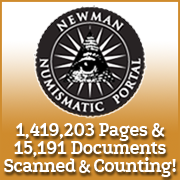
About UsThe Numismatic Bibliomania Society is a non-profit organization devoted to the study and enjoyment of numismatic literature. For more information please see our web site at coinbooks.org SubscriptionsThose wishing to become new E-Sylum subscribers (or wishing to Unsubscribe) can go to the following web page link MembershipThere is a membership application available on the web site Membership Application To join, print the application and return it with your check to the address printed on the application. Print/Digital membership is $40 to addresses in the U.S., and $60 elsewhere. A digital-only membership is available for $25. For those without web access, write to: Terry White, Treasurer AsylumFor Asylum mailing address changes and other membership questions, contact Terry at this email address: terrywhite5475@yahoo.com SubmissionsTo submit items for publication in The E-Sylum, just Reply to this message, or write to the Editor at this address: whomren@gmail.com BUY THE BOOK BEFORE THE COINSale Calendar |
- WAYNE'S WORDS: THE E-SYLUM OCTOBER 15, 2017
- KOLBE & FANNING SALE 147 RESULTS
- NEW BOOK: PAPER MONEY OF THE U.S. 21ST EDITION
- NEW BOOK: DISCOVERING VIRGINIA’S COLONIAL ARTIFACTS
- NEW BOOK: COINS OF FRENCH INDOCHINA
- NEW BOOK: COINS OF URUGUAY 1831-2017
- NGC OPENS COUNTERFEIT DETECTION PORTAL
- ANS MONEY TALKS: THE FUTURE OF DIGITIZATION
- NEWMAN PORTAL ADDS COIN GALLERIES CATALOGS
- NEWMAN PORTAL SEARCH: JAMES II PLANTATION TOKEN
- JOHN KRALJEVICH JOINS THE NEWMAN PORTAL
- COLUMBIAN ANACREONTIC SOCIETY MEMBER'S MEDAL
- U.S. MINT DIRECTORS WHO SERVED TWO TERMS
- MAUNOVRY'S LESHER DOLLAR HOARD QUESTIONED
- NOTES FROM E-SYLUM READERS: OCTOBER 15, 2017
- QUERY: U.S. MINT MEDAL IMAGES SOUGHT
- KRUGERRAND FONT WINS AWARD
- VOCABULARY TERM: MINT SET
- LEOPOLD HAMBURGER (1836-1902)
- MORE ON THE RENOVATED MONNAIE DE PARIS
- WORLD WAR I COMMEMORATIVE SCULPTOR LEROY TRANSFIELD
- AMERICAN BANK NOTE COMPANY COLLAGES
- MORE ON THE ORIGINS OF THE CONTINENTAL DOLLAR
- THE CURIOUS BOGGS ONE EURO NOTE
- RICHARD JEWELL EXONUMIA AT PAN SHOW
- NUMISMATIC NUGGETS: OCTOBER 15, 2017
- MISSOURI RARITIES IN NEWMAN PART VIII
- NEWMAN PART IX SALE HIGHLIGHTS
- RARE GOLD WELLS FARGO PONY EXPRESS RACE MEDAL
- COINWEEK ANCIENT COIN COLLECTORS GUILD ARTICLE
- MORE ON COMPTROLLER OF THE CURRENCY REPORTS
- SCOTLAND MONEY MUSEUM CLOSING
- FINEST 1820 NORTH WEST COMPANY TOKEN
- INTERESTING INSCRIBED 1861 WINCHESTER, VA NOTE
- 1926 KU KLUX KLAN WASHINGTON D.C. MARCH TOKEN
- CLAIMANTS FINALLY RECOVER LIBERTY DOLLAR ASSETS
- GALVANO RELIEFS: GILDING THE LILLY
- FEATURED WEB PAGE: THE SONG ECONOMIC REVOLUTION
Click here to access the complete archive
To comment or submit articles, reply to whomren@gmail.com
Content presented in The E-Sylum is not necessarily researched or independently fact-checked, and views expressed do not necessarily represent those of the Numismatic Bibliomania Society.
WAYNE'S WORDS: THE E-SYLUM OCTOBER 15, 2017
 New subscribers this week include: Kevin Thompkins of Nashville, TN, courtesy of Bob Hurst; Dan Hansen of the Minnesota Historical Society, courtesy of Pete Smith; Rich Ponder, courtesy of
Chip Howell; Quentin Christensen, Braydon Ballow, Bill Dancy, and M. Wallace. Welcome aboard! We now have 3,298 subscribers. Can we hit 3,300 next week?
New subscribers this week include: Kevin Thompkins of Nashville, TN, courtesy of Bob Hurst; Dan Hansen of the Minnesota Historical Society, courtesy of Pete Smith; Rich Ponder, courtesy of
Chip Howell; Quentin Christensen, Braydon Ballow, Bill Dancy, and M. Wallace. Welcome aboard! We now have 3,298 subscribers. Can we hit 3,300 next week?
Thank you for reading The E-Sylum. If you enjoy it, please send me the email addresses of friends you think may enjoy it as well and I'll send them a subscription with your compliments. Contact me at whomren@gmail.com anytime regarding your subscription, or questions, comments or suggestions about our content.
This week we open with some great results for Kolbe & Fanning sale #147, four new books, an ANS forum on numismatic digitization and multiple updates from the Newman Numismatic Portal.
Other topics this week include counterfeit detection, Coin Galleries, The American Plantation token, the 1820 North West Company token, U.S. Mint Directors, coin font design, dealer Leo Hamburger, sculptor Leroy Transfield, Continental Dollars, the Pony Express race gold medal, and Liberty Dollars.
To learn more about the first edition Blue Book, Friedberg’s Paper Money of the U.S., coins of Uruguay, the Columbian Anacreontic Society, the Monnaie de Paris, American Bank Note Company collages, the J.S.G. Boggs One Euro note, the First Transatlantic Flight medal, pre-banking bon scrip, Beaver Bills and galvano reliefs, read on.
NOTE: Your Editor will be traveling next week, so that issue of The E-Sylum may be delayed or shortened. Have a great week, everyone!
Wayne Homren
Editor, The E-Sylum

KOLBE & FANNING SALE 147 RESULTS
 The October 7 sale of material from the libraries of William A. Burd and Q. David Bowers, held by Kolbe & Fanning Numismatic Booksellers, was a resounding success, with particularly strong
activity seen in the American part of the sale. Some highlights included:
The October 7 sale of material from the libraries of William A. Burd and Q. David Bowers, held by Kolbe & Fanning Numismatic Booksellers, was a resounding success, with particularly strong
activity seen in the American part of the sale. Some highlights included:
Lot 413, John J. Ford’s own bound set of New Netherlands Coin Company sales, brought $1400 on a $750 estimate (all results are hammer prices without premium added)
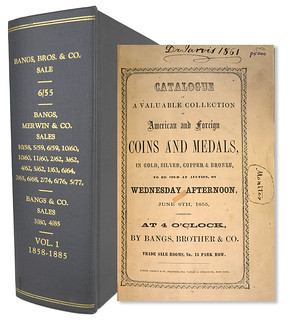 Lot 287, a bound volume of twenty early Bangs sales, from the Fuld, Bass and Bowers libraries, sold for $1100 on a $500 estimate
Lot 287, a bound volume of twenty early Bangs sales, from the Fuld, Bass and Bowers libraries, sold for $1100 on a $500 estimate
Lot 309, a plated example of the very scarce S.H. & H. Chapman sale of the Dohrmann mineral collection, sold for $950 on a $250 estimate
Lot 355, a bound volume from the Virgil Brand library consisting of thirteen auction catalogues from 1874 and a letter from John W. Haseltine, brought $850 against a $300 estimate
 Lot 298, a copy of the deluxe presentation edition of the Bowers & Merena Norweb sales, from the library of Q. David Bowers, brought $800 on a $500 estimate
Lot 298, a copy of the deluxe presentation edition of the Bowers & Merena Norweb sales, from the library of Q. David Bowers, brought $800 on a $500 estimate
Lot 486, a first edition Blue Book, signed by editor R.S. Yeoman, brought $750 on a $100 estimate
Lot 428, a bound volume including 28 Scott & Company auction catalogues, sold for $700 on a $300 estimate
Lot 363, an unlisted copy of Heath’s popular counterfeit detector, sold for $650 on a $200 estimate
Lot 468, a priced copy of the Joseph J. Mickey sale held by W. Elliot Woodward in 1867, in a contemporary binding, received bids from many parties and brought $650 on a $200 estimate
Lot 279, a copy of the rare first membership list of the American Numismatic Association (1908) brought $550 on a $200 estimate.
While U.S. material dominated this sale, it included some nice material on foreign and ancient coins, with four volumes of Mitchiner’s work on jetons bringing $550 on a $250 estimate, A.M. Tracy Woodward’s work on The Minted Ten-Cash Coins of China bringing $450 on a $250 estimate, a nice first edition copy of Head’s Historia Numorum bringing $275 on a $100 estimate, and Støren and Holst’s rare work on the medals of Ivar Throndsen bringing $275 on a $100 estimate.
Our next auction will be our annual New York Book Auction held in conjunction with the New York International Numismatic Convention on Saturday, January 13. Held in Empire State Ballroom I of the Grand Hyatt Hotel, beginning at 12:30 pm, the auction will include the highlights of the comprehensive library formed by Chicago numismatist William A. Burd, among other properties, and promises to be an exceptional sale. In the meantime, we plan to hold an online “Buy or Bid Sale” in the next couple months and hope to issue a new fixed-price PDF catalogue as well, so stay tuned for more announcements! Our website is numislit.com .

NEW BOOK: PAPER MONEY OF THE U.S. 21ST EDITION
21st Edition of Friedberg’s Paper Money of United States, in full color, to be released in multiple formats on October 23
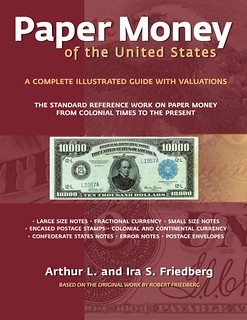 Sixty-four years after its introduction, the twenty-first edition of Paper Money of United States, the standard reference book on United States paper money, is being released by the
Coin & Currency Institute. In 1953, the late Robert Friedberg (1912-1963) broke new ground when the Treasury Department granted permission for photographs of American paper money to be printed
for the first time. The current edition's 328 pages sets the standard once again by featuring notes from America's greatest currency collections, all reproduced in color. The inaugural
edition of Paper Money of the United States also introduced other innovations never before attempted. The subject became standardized and the book earned a permanent place on reference
shelves. During the past three decades, it has been completely expanded, revised, and edited by Arthur L. Friedberg and Ira S. Friedberg.
Sixty-four years after its introduction, the twenty-first edition of Paper Money of United States, the standard reference book on United States paper money, is being released by the
Coin & Currency Institute. In 1953, the late Robert Friedberg (1912-1963) broke new ground when the Treasury Department granted permission for photographs of American paper money to be printed
for the first time. The current edition's 328 pages sets the standard once again by featuring notes from America's greatest currency collections, all reproduced in color. The inaugural
edition of Paper Money of the United States also introduced other innovations never before attempted. The subject became standardized and the book earned a permanent place on reference
shelves. During the past three decades, it has been completely expanded, revised, and edited by Arthur L. Friedberg and Ira S. Friedberg.
As with any price catalog, the twenty-first edition of Paper Money of the United States is a snapshot in time – and as the new edition debuts, it shows that the market for paper money market is stable, with notes of great rarity or top quality often setting price records every time they are sold. As with every edition, all valuations have been adjusted to reflect market conditions, which are mostly up. These prices are given in up to seven states of preservation from Very Good (VG8) to Gem Uncirculated (Gem65). There are also several other significant additions and revisions to the new volume, including motes never before known to exist, making it a necessity for every collector and dealer of American currency.
From the first year of Federal paper money, 1861, to the present, the fronts and backs of all classes and types of currency, from 3 cents to 10,000 dollars are illustrated. These are accompanied by text listing, describing and pricing every variety of paper money ever issued, more than 10,000 prices in all. With close to 1,000 color photographs, the result is a complete pictorial, descriptive and numismatic history of the currency of the United States. There are supplemental sections on Continental and Colonial Currency (notes issued from 1680 to 1788), the Treasury Notes of the War of 1812, considered by some to be the first national currency, a comprehensive listing by type of the issues of the Confederate States of America, and sections devoted to paper money errors, postage envelopes, and encased postage stamps. The latter two, along with Fractional Currency, were created to alleviate the shortage of change needed for commerce during the Civil War. The listing in the Appendix of the 14,348 National Banks that existed from 1863 to 1929 also shows the numbers of large size and small size (more . . .) notes known to exist for each note-issuing bank. The Appendix also includes information on uncut sheets of small-size notes, including the modern issues sold by the Bureau of Engraving and Printing,
Paper money collectors depend on the Friedberg Numbering System™, a uniform method of cataloging bank notes that is the international standard for American currency. This numbering shorthand, along with the hundreds of photographs, enables anyone to instantly locate a specific banknote, and allows a dealer to advertise a note without need of extensive description. A distinguished panel of acknowledged experts on paper money has assisted the authors, enabling them to establish accurate and up-to- the minute valuations for all issues.
Paper Money of the United States has been an invaluable asset to currency collectors and numismatists for generations. It possesses an appeal and value of its own, not just to lovers of Americana and of the fine art of engraving, but to students of American history, finance and economics. It is recognized as a landmark work and is the undisputed standard reference on American currency – internationally acknowledged as the most comprehensive and universally quoted guide on the subject. Banks in America and throughout the world will find this book especially useful in that it makes possible the immediate identification of all obsolete but still legal tender paper money, while simultaneously giving the collector’s value of each note.
It is a book which belongs in every library, public and private. Sample pages from the 21st edition may be seen on the book’s website, www.PaperMoneyoftheUS.com.
The book is printed in the United States and is available in three formats. A low-price, easy to carry soft cover version (ISBN 978-087184- 521-4) is $42.50. A long-lasting, hard-bound copy with sewn binding (ISBN 978087184-721- 8) is $67.50. An e-book edition (ISBN 978-087184- 021-9) costs $29.50 and is also offered as a one-day rental. The books are available or may be ordered from book stores, coin and paper money dealers, and from internet book sellers. Copies may also be obtained from the Coin & Currency Institute, P.O. Box 399, Williston, Vermont 05495. $5.75 should be added to each order for shipping and handling. Major credit cards are accepted. Call toll-free 1-800- 421-1866. Fax (802) 536-4787. E-mail: info@PaperMoneyoftheUS.com.
For more information, see:
Paper Money of the United States - 21st edition (http://www.coin-currency.com/page8.html)
NEW BOOK: DISCOVERING VIRGINIA’S COLONIAL ARTIFACTS
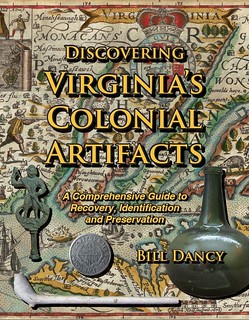 This book, entitled Discovering Virginia's Colonial Artifacts - A Comprehensive Guide to Recovery, Identification and Preservation, is 400 pages in length and packed with nearly
1000 color photos of 16th thru 18th century artifacts the author has personally recovered over the last 20+ years along with many quality post-colonial finds that randomly turn up at early sites.
It’s believed to be the first of its kind in this subject matter area to hit the market. But don’t be misled by the title as this is a must-have not only for colonial enthusiasts, but for all novice
and veteran relic hunters as well as it covers a wide range of pertinent topics including research methods, how to secure permission, reading and searching sites, finding and excavating trash pits,
artifact cleaning, preservation, documentation and display, ethics, and much more.
This book, entitled Discovering Virginia's Colonial Artifacts - A Comprehensive Guide to Recovery, Identification and Preservation, is 400 pages in length and packed with nearly
1000 color photos of 16th thru 18th century artifacts the author has personally recovered over the last 20+ years along with many quality post-colonial finds that randomly turn up at early sites.
It’s believed to be the first of its kind in this subject matter area to hit the market. But don’t be misled by the title as this is a must-have not only for colonial enthusiasts, but for all novice
and veteran relic hunters as well as it covers a wide range of pertinent topics including research methods, how to secure permission, reading and searching sites, finding and excavating trash pits,
artifact cleaning, preservation, documentation and display, ethics, and much more.
It basically doubles as both a “how-to” manual as well as a colonial artifact “encyclopedia” covering all major categories to help more precisely identify and date your finds. It also contains 40 sidebars scattered throughout the book that expand on various topics of interest plus a listing of “Suggested Resources” at the end of most chapters that identifies other publications, websites, technical papers, etc, for additional reading if desired. The book also includes nine appendices to provide supplemental material. It’s also printed in all color on high quality, glossy stock and is contained within a heavy and attractive hardcover.
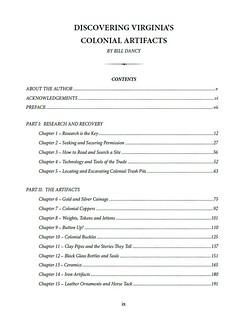
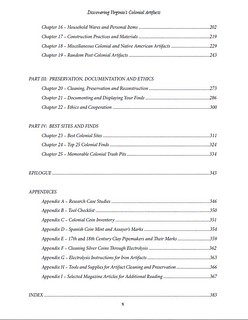

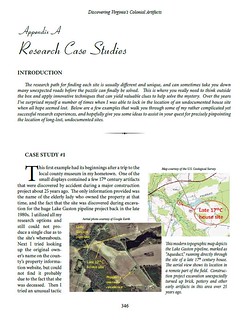
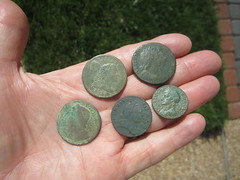
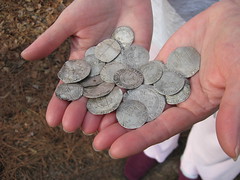
Anyone that may be interested in purchasing a copy can contact the author directly at bdancy97@charter.net, or it can be purchased via PayPal by clicking on https://www.paypal.me/ColonialArtifacts. The book is $59 + $5 shipping (continental US only), and the author will sign any copies as requested (he’s selling all books at this time from his home).
For more information, or to order, see:
https://www.paypal.me/ColonialArtifacts
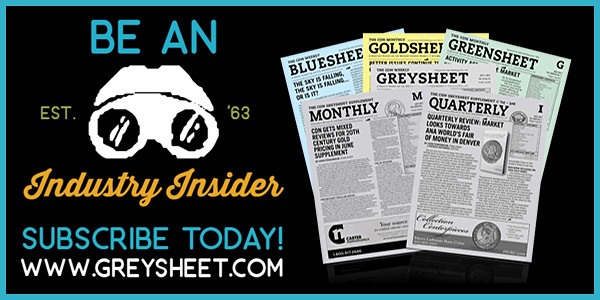
NEW BOOK: COINS OF FRENCH INDOCHINA
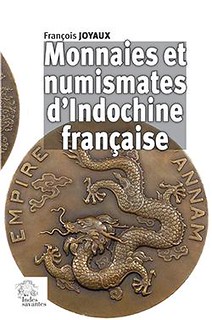 The author proposes a study as complete as possible on the history of the currencies of Vietnam, as well as Laos and Cambodia. The subject has received little attention in books dating back
to the beginning of the twentieth century.
The author proposes a study as complete as possible on the history of the currencies of Vietnam, as well as Laos and Cambodia. The subject has received little attention in books dating back
to the beginning of the twentieth century.
The French colonizers discover a complex monetary system, inspired by China, and very different from that which exists in Europe. They will try to use these very diverse currencies, often of very low value (but corresponding to the economic needs of the Vietnamese), to copy them by striking sapeques in France.
But colonial economic interests demanding higher values ??will gradually prevail, and piastres, dollars and other "big" pieces will appear.
The author devotes a large part to the technicians and methods of coinage of these coins, as well as to numismatists who, from the end of the nineteenth century have studied local plays, as well as to the beautiful collections existing today in different institutions French.
Format: 158 x 240 mm - Square back
Date of publication: 2017
ISBN: 978-2-84654-470-2
Price: 29,00 €
For more information, see:
Monnaies et numismates d’Indochine française (http://www.lesindessavantes.com/ouvrages/24675)
To visit the NBS Facebook group, see:
Numismatic Bibliomania Society Public Group (https://www.facebook.com/groups/1145253708909091/)
NEW BOOK: COINS OF URUGUAY 1831-2017
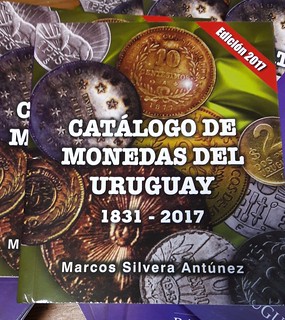 "Coin catalog of Uruguay 1831-2017"
"Coin catalog of Uruguay 1831-2017"Author: Marcos Silvera Antúnez.
9th edition, 2017.
Editions "The Galeón".
A new edition of the traditional coin catalog Uruguayan President, Marcos Silvera Antúnez, former President of our Institution. It maintains, in its 56 pages, its format of 12.5 x 14.8 centimeters that makes it very attractive for quick consultation. Includes the latest currencies issued by the Bank Central Uruguay (BCU): from the bimetallic currency 2015 (coined to commemorate the bicentenary of the Land Regulations of 1815) to the last two commemorative issues (the coin alluding to the "Industrial and Cultural Landscape of Fray Bentos - World Heritage" and the commemorating the fiftieth anniversary of creation of the BCU).
To read the complete article, see:
Coin Catalog 2017 Uruguay - Catalogo Monedas Uruguayas de 1831 a 2017 56
Pag. (http://www.ebay.com/itm/Coin-Catalog-2017-Uruguay-Catalogo-Monedas-Uruguayas-de-1831-a-2017-56-Pag-/172834431702)
To read the earlier E-Sylum article, see:
EL SITIO NO. 24 PUBLISHED (http://www.coinbooks.org/v20/esylum_v20n40a06.html)
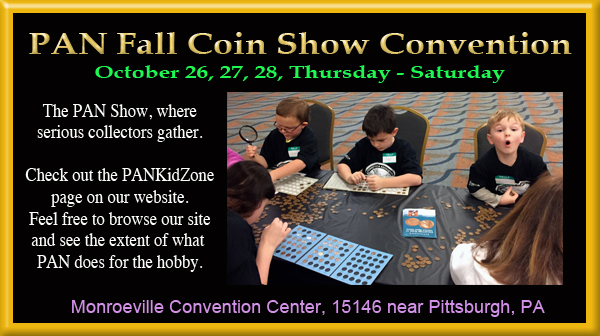
NGC OPENS COUNTERFEIT DETECTION PORTAL
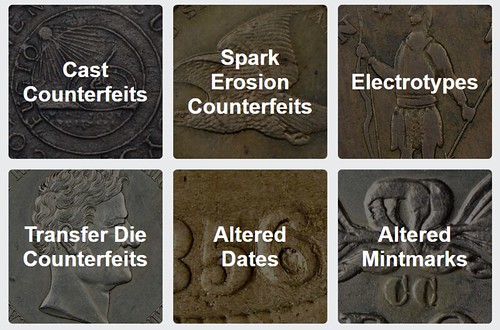
Numismatic Guaranty Corporation® (NGC®) has launched an online Counterfeit Detection resource, leveraging its decades of authentication expertise.
Hosted at NGCcoin.com/counterfeits, the resource features the 50 US coins and 25 Chinese coins most commonly targeted by counterfeiters. Each of these coins has on its own page, with high-resolution images, the type of counterfeits of it typically seen, tips for detecting these counterfeits and other helpful information.
This valuable resource was assembled under the direction of Rick Montgomery, NGC President, Finalizer and one of the world’s foremost coin authenticators. Many members of the NGC grading team also provided research and insights. NGC's graders have identified more than 100,000 counterfeit and altered coins since 1987.
The resource puts a spotlight on such coins as the 1909-S VDB Lincoln Cent, the most commonly counterfeited US coin, according to submissions to NGC. The Year 23 (1934) Junk L&M-110 Dollar, named for the ship on its reverse, is the most commonly seen counterfeit of a Chinese coin, according to submissions to NGC.
Other highlights of the resource’s lists of counterfeit coins:
- The 1916-D Mercury Dime is the second most commonly seen U.S. counterfeit.
- All 15 issues of the Indian $2.50 that were minted in the early 1900s made the list of the top 50 U.S. counterfeits, comprising nearly a third of the list.
- The 2000 Silver Panda 10 Yuan, a modern coin popular with collectors, made the list of the top Chinese counterfeits at No. 15.
- The Year 17 (1928) Kweichow L&M-609 Dollar, often called the “Auto Dollar” because of the vehicle depicted on it, was among the top 10 Chinese counterfeit coins, which are all early 20th century dollars.
The Counterfeit Detection portal also includes a section that explains what distinguishes the different types of fakes, which include cast, spark erosion, electrotype and transfer die counterfeits, as well as altered dates and altered mintmarks.
To visit the NGC Counterfeit Detection site, see:
https://www.ngccoin.com/resources/counterfeit-detection/
To read the complete article, see:
NGC Helps Collectors and Dealers Identify Counterfeit Coins
(https://www.ngccoin.com/news/article/6185/counterfeit-detection-resource/)
ANS MONEY TALKS: THE FUTURE OF DIGITIZATION
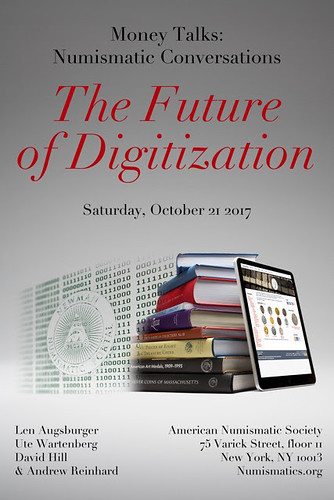 The Future of Digitization
The Future of Digitization
Len Augsburger (Newman Numismatic Portal), Ute Wartenberg, David Hill, & Andrew Reinhard
October 21, 2017 | 11:00 am - 6:00 pm
$50 for members / $85 for nonmembers
Attendance Limit: 30 People
Please join us Saturday, October 21 at 11:00 AM for our next Money Talks. The field of numismatics remains uniquely placed for contributing to the digital future of the Humanities. Join Len Augsburger, Andrew Reinhard, Ute Wartenberg, and David Hill for an extended look at digitization, linked open data, and Open Access in which the ANS has played a role as a global leader and innovator.
Partnerships with the Newman Numismatic Portal, the Internet Archive, HathiTrust, the Google Cultural Institute, and other organizations continue to push the digital envelope, allowing the sharing of high-quality data and images to fellow numismatists, historians, economists, archaeologists, collectors, as well as the interested public.
See these latest advances in technology first-hand, and get a glimpse into the future of digitization of coins, catalogues, and content at the ANS and beyond. Space is limited. Early registration is encouraged. $50 for members/$85 for nonmembers, lunch included.
Please RSVP to: Emma Pratt at membership@numismatics.org or call: 212-571-4470 ext. 117
Money Talks: Numismatic Conversations is supported by the ANS endowment fund generously given in honor of Dr. Vladimir Clain-Stefanelli and Mrs. Elvira Clain-Stefanelli.
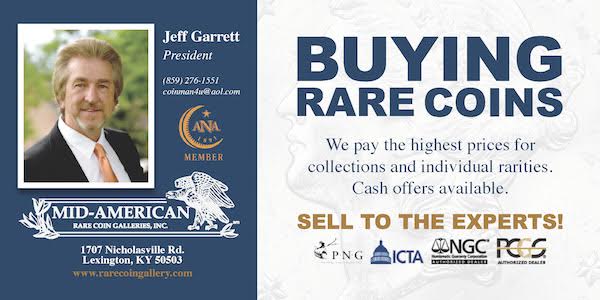
NEWMAN PORTAL ADDS COIN GALLERIES CATALOGS
Newman Portal Adds Stack’s Coin Galleries Auction Catalogs
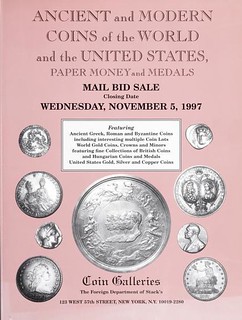 Multi-tiered branding is a popular business strategy, well known from the consumer marketing initiatives of companies such as General Motors and Anheuser Busch. Did you belong to a Pontiac,
or an Oldsmobile family? The division into multiple brands fed consumer aspiration and allowed buyers to socially distinguish themselves as they wished. Stack’s had precisely the same thought in 1953
with the launch of the “Coin Galleries” brand.
Multi-tiered branding is a popular business strategy, well known from the consumer marketing initiatives of companies such as General Motors and Anheuser Busch. Did you belong to a Pontiac,
or an Oldsmobile family? The division into multiple brands fed consumer aspiration and allowed buyers to socially distinguish themselves as they wished. Stack’s had precisely the same thought in 1953
with the launch of the “Coin Galleries” brand.
These auctions included more accessible material not always suited for their frontline sales. The nature of the rare coin business dictated that vast quantities of such material would flow through the doors of the 57th street mainstay, and the creation of Coin Galleries furnished an outlet to promote this segment of the market. The Newman Portal has added 145 of these catalogs, spanning the period 1954-2009. Thanks to Jerry Fochtman for loaning portions of this material, and to Stack’s Bowers for permission to scan and host it on the Newman Portal.
Link to Coin Galleries auction sale catalogs on Newman Portal:
https://nnp.wustl.edu/library/auctioncompanydetail/510515
NEWMAN PORTAL SEARCH: JAMES II PLANTATION TOKEN
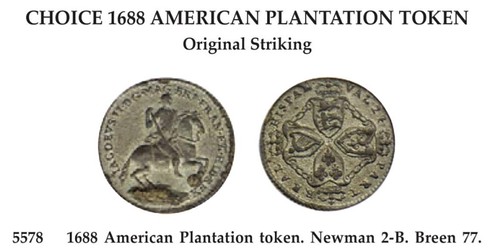
From Stack’s January 2008 Americana sale
An anonymous user entered the term “James II Plantation Token” into Newman Portal this week. These pewter coins were struck in England in 1688 and intended to circulate in the American colonies, at a value of 1/24 Real, alongside Spanish coinage which was more readily accepted. The reverse design is evocative of the (Spanish) Pillar dollar. The Plantation pieces are among the more collectible early colonial coins – a nice example in Stack’s Americana sale (January 2008, lot 5578) sold for $2,300.
Eric Newman wrote to John Ford, Jr. in January 1955 “I am working up the information on the plantation token which I now can date 1688..so far I have found three reverse dies and two obverse dies.” Subsequent letters in the same file show that Newman relied on Leonard Forrer in England for research assistance, studied pieces in the ANS collection, and acquired a Plantation token restrike from Ford.
Newman similarly wrote to B. Max Mehl in February 1955 “I have been doing a great deal of historical research lately…and have found the authority for the James II Plantation token which will be published in The Numismatist soon.” Newman’s article, “First Documentary Evidence of the American Colonial Pewter 1/24th Real” appeared in the July 1955 Numismatist. The research demonstrated the coins were likely struck at the Royal Mint under a private commission in 1688. Newman detailed the known varieties (six obverse and six reverses), and credited Forrer for his assistance.
Link to John Ford, Jr. 1955 correspondence:
https://nnp.wustl.edu/library/book/519031?page=0
Link to B. Max Mehl 1955 correspondence:
https://nnp.wustl.edu/library/book/531646?page=15
Link to Stack’s January 2008 Americana sale:
https://nnp.wustl.edu/library/auctionlots?AucCoId=3&AuctionId=516991&page=133
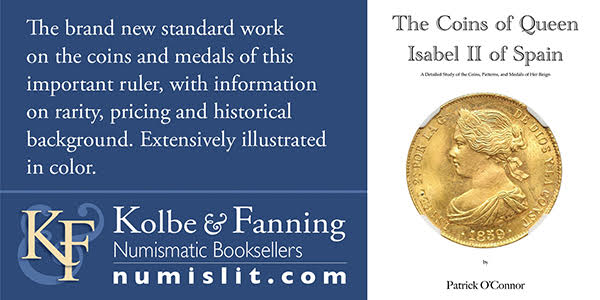
JOHN KRALJEVICH JOINS THE NEWMAN PORTAL
 If you've visited the Newman Numismatic Portal recently, you've seen the new home page layout, image gallery, and blogs. NNP's newest blogger is John Kraljevich - here's his
inaugural post from October 4, 2017. -Editor
If you've visited the Newman Numismatic Portal recently, you've seen the new home page layout, image gallery, and blogs. NNP's newest blogger is John Kraljevich - here's his
inaugural post from October 4, 2017. -EditorThe Portal Opens
The root of Eric Newman’s genius for numismatic research is twofold: first, deep sourcing, employing the best numismatic and non-numismatic resources; second, an ability to synthesize these widely disparate materials to tell a story no one has ever told before. There have been relatively few American numismatic researchers who have had the ability and the resourcefulness to accomplish truly original research. The boundaries have always been high, necessitating the gathering of a substantial library (and, often, a substantial budget to build it), travel to visit other collectors and repositories, and enough of a background in the non-numismatic allied disciplines of art, history, geography, and economics to make sense of it all.
With the introduction of the Newman Numismatic Portal, the height of those boundaries drops appreciably.
It would take a lifetime to gather these materials, but even then they would scarcely be as useful to a researcher as they are here. From mainstream references to runs of auction catalogs that contain information published nowhere else, the works made available on the Newman Numismatic Portal are fully indexed and searchable, giving researchers a chance to locate a long forgotten tidbit through means other than serendipity. Original research articles published in rare or obscure periodicals from the 19th century to today have long been underutilized; with the Newman Numismatic Portal, they come to the forefront. Manuscript materials, including the remarkable Newman archives and treasures from the library of the American Numismatic Society, are now available to researchers worldwide, a resource that makes this website a worthy addition to numismatic knowledge even were they the only things here.
But one need not be a serious numismatic researcher to find the portal useful. An unfamiliar medal may well be instantly identified by doing nothing more than keying in the words of its inscription. The rarity of a numismatic item may be revealed by a dearth of appearances in the auction listings archived here (or, on the flip side, it may be proven to be relatively common despite the marketing hype). A story that deserves to be widely known may be found to have been told just once and forgotten, refilling a gap that brings light to a more profound historical narrative.
For academics and non-numismatic writers, numismatics offers photogenic and easily understood relics of material culture, both lowly and profound. Unlike collectors, who cherish the rare and valuable, historians may find that numismatic items that are commonplace or nearly worthless serve as an ideal symbol or illustration, whether it be the token Rosa Parks dropped into the fare box before she famously found her seat on a Montgomery, Alabama bus, the medals Thomas Jefferson brought from Paris to deliver to George Washington on behalf of a grateful nation, or the Confederate $5 that was in Abraham Lincoln’s pocket when he died. Those stories, and thousands more, are here, ripe for the picking.
Eric Newman has spent nearly a century telling these stories. I’ve only been at it a couple decades, leaving me as a mere pup by comparison. With an historian’s ethic and a collector’s heart, I’ll be sifting the remarkable gifts of the Newman Numismatic Portal on a regular basis to identify stories to share. It’s akin to standing atop Cerro Rico, the mountain full of silver ore at Potosi: extraordinary treasures lie beneath the surface, just waiting to be uncovered. I’m excited to be the “chief storytelling officer” for the Newman Numismatic Portal, and excited to dig up what’s still hidden. I’ve got my pick and shovel ready.
To read the complete article, see:
The Portal Opens #1: John Kraljevich Joins NNP (https://nnp.wustl.edu/blog-post/514743)
COLUMBIAN ANACREONTIC SOCIETY MEMBER'S MEDAL
Scott Miller of Maplewood, NJ writes:
Regarding the recent discussion of engraved medals, I have attached scans of a member’s ticket or pass from the Columbian Anacreontic Society, a music society that existed in New York from about 1795 to 1803. To the best of my knowledge, this has never appeared in any numismatic publication; an article is currently in preparation.
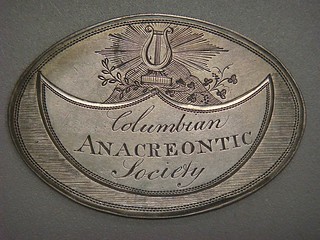
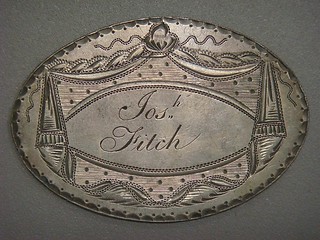
To read the earlier E-Sylum article, see:
MORE ON EARLY ENGRAVED U.S. MEDALS (http://www.coinbooks.org/v20/esylum_v20n41a09.html)
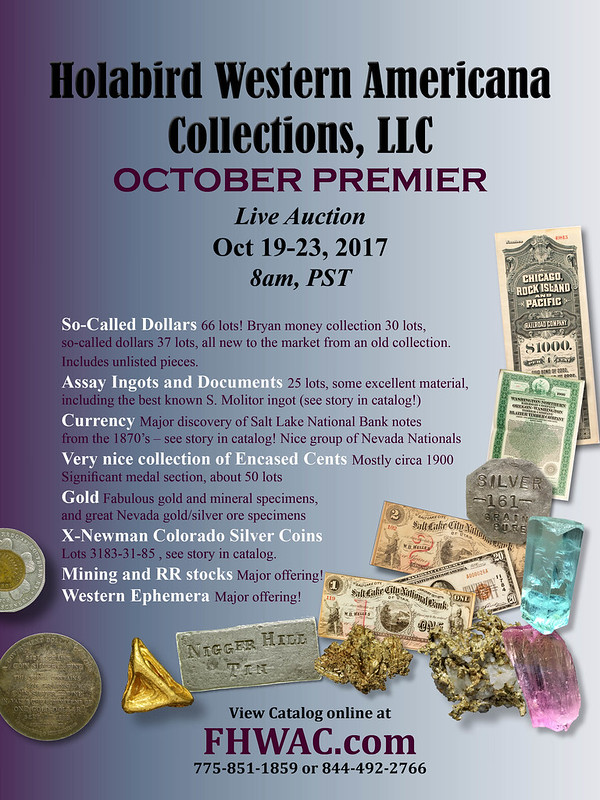
U.S. MINT DIRECTORS WHO SERVED TWO TERMS
Pete Smith writes:
Henry Richard Linderman served two non-consecutive terms as Director of the Mint. So did George E. Roberts.
Citizens Coinage Advisory Committee Chair Mary Lannin writes:
I am looking forward to meeting newly-appointed US Mint Director David Ryder. However, he would not be the first Mint Director to serve separate terms.
James Pollock, A.M., L.L.D.
Pennsylvania May 1861–September 1866
James Pollock, A.M., L.L.D.
Pennsylvania May 1869–March 1873
Richard Henry Linderman, M.D.
Pennsylvania April 1867–May 1869
Richard Henry Linderman, M.D.
Pennsylvania April 1873–December 1878
And in a father/son combination, we find:
Robert Patterson, LL.D.
Pennsylvania January 1806–July 1824
Robert Maskell Patterson, M.D.
Pennsylvania May 1835–July 1851
| Name | Assumed Office | Left Office | President Appointed By |
|---|---|---|---|
| James Pollock | May 1861 | September 1866 | Abraham Lincoln |
| Henry Linderman | April 1867 | May 1869 | Andrew Johnson |
| James Pollock | May 1869 | March 1873 | Ulysses S. Grant |
| Henry Linderman | April 1873 | December 1878 | Ulysses S. Grant |
| George E. Roberts | February 1898 | July 1907 | William McKinley |
| George E. Roberts | July 1910 | November 1914 | William Howard Taft |
| David J. Ryder | September 1992 | November 1993 | George H. W. Bush |
| David J. Ryder | Donald J. Trump |
To read the complete article, see:
Director of the United States Mint (https://en.wikipedia.org/wiki/Director_of_the_United_States_Mint)
To read the earlier E-Sylum article, see:
DAVID J. RYDER (RE)NOMINATED AS MINT DIRECTOR (http://www.coinbooks.org/v20/esylum_v20n41a07.html)

MAUNOVRY'S LESHER DOLLAR HOARD QUESTIONED
Apparently Leonard missed the point and value of my biography of Jean Fabien Maunovry. Since the Federal Government of the United States of America via its U. S. Postal Inspectors and Investigators as well as the legal system of the courts in the states of the United States found Maunovry guilty of fraud, deception, theft, and dishonesty, his testimony about how and what and what quantity he acquired about any item numismatic or otherwise should be more critically scrutinized.
Consequently, a critical and objective treatment of the information necessitates describing whatever Maunovry has said about anything as his “claim”. Farran Zerbe was completely unaware of what we know about Maunovry as a shady character who criminally acquired some or most of his stock for sale. It seems incredible that a man of his nature actually did legitimately pay anyone for such a large quantity of Lesher dollars. I am inclined to think his claim about the 1905 purchase was nothing more than a tall story, i.e.. a pure fabrication.
None of these obvious and logical criticisms necessitates our denying he actually did have in his possession a large quantity of Lesher dollars. Studying Maunovry’s character one is inclined to believe he actually had more inventory of Lesher dollars and other items than he cared to show his hand about.
Now the only legitimate criticism Leonard may have had is that I "tongue in cheek" asserted Maunovry had made the famous 1905 purchase in the great historic and wonderful city of Denver in the lovely and beautiful state of Colorado. But, I do not think that is any great peccadillo on my part since I did not actually believe any such transaction took place to begin with.
To read the earlier E-Sylum articles, see:
JEAN FABIEN MAUNOVRY (1878-1942) (http://www.coinbooks.org/v20/esylum_v20n40a21.html)
MORE ON MAUNOVRY'S LESHER DOLLAR HOARD (http://www.coinbooks.org/v20/esylum_v20n41a14.html)
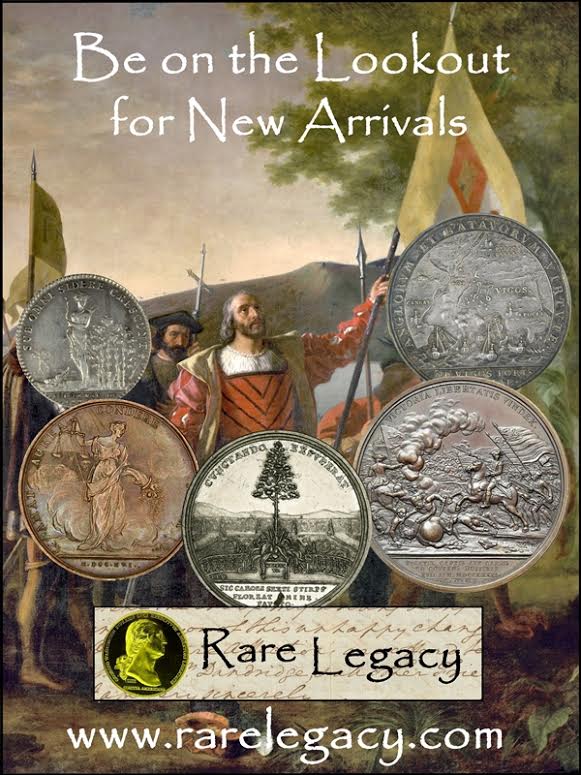
NOTES FROM E-SYLUM READERS: OCTOBER 15, 2017
E-Sylum Wins The Harvey Prize
Harvey Stack writes:
The stories, research and information in The E-Sylum keeps me up in the late hours of Sunday, and I usually wake up early the next morning wanting to continue my "reading" and "education" which you support each week.
You know this is the month for Nobel Prizes, and I wish they were given for Numismatic endeavors, for you would capture the prize. Keep what you are doing - the hobby needs the education you provide.
WSJ on J.P. Morgan
Dave Hirt of Frederick, MD writes:
In Monday's Wall Street Journal there was an article on the many different items collected by J. P. Morgan. It covered 5/8 of a page. However, there was NOT ONE word about his numismatic interest. Looks like coin collectors take a back seat in the Journal's opinion.
On What to Call Those Dots in Legends
Ken Spindler of San Diego writes:
Any type of tiny symbol separating words in a coin or medal legend is commonly known as a "stop." Despite the possible inference from the ordinary meaning of the word, not all stops appear only at the end of a legend. In fact, it's probably rare that they do. As the article indicates, not all stops are dots. Regardless, roundish stops are often called "pellets" in cataloguing descriptions. I'm not certain whether to qualify as a "pellet" a stop by definition must be non-round to some extent. If a (round) dot would qualify as a variety of pellet, since all pellets are certainly not round, maybe a dot can be called a "round pellet." Inasmuch as I just made that term up, obviously it is not what anybody calls dots separating words in legends. Not yet, anyway.
Dick Johnson adds:
Like Ken states, I too have seen “stops” used in catalog descriptions. A legitimate use of Stops were at the end of every sentence in telegrams. Remember those? Center dots far more accurate term and easier to understand.
To read the earlier E-Sylum articles, see:
WHAT DO WE CALL THOSE DOTS IN LEGENDS? (http://www.coinbooks.org/v20/esylum_v20n41a11.html)
VOCABULARY TERM: LEGEND (http://www.coinbooks.org/v20/esylum_v20n41a12.html)
More Chopmarks on US $20 Bills
Terry Frazier of Missouri Valley, IA writes:
I found more chopmarks on a 20$. Hard to make one out. The one on corner is a eagle head. Another is a name.
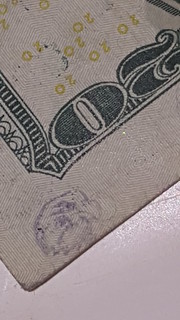
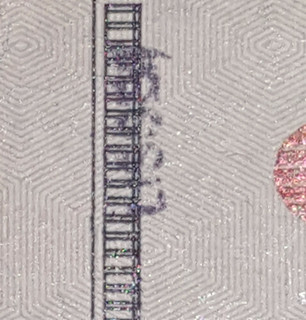

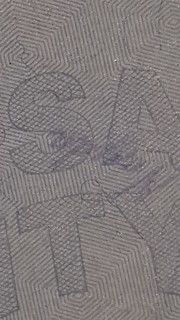
To read the earlier E-Sylum article, see:
NOTES FROM E-SYLUM READERS: OCTOBER 1, 2017 : Chopmarks on a US $20 bill (http://www.coinbooks.org/v20/esylum_v20n40a12.html)
THE BOOK BAZARRE
QUERY: U.S. MINT MEDAL IMAGES SOUGHT
I’m looking for high-resolution photographs (obverse and reverse) of the following medals and other U.S. Mint productions. If any E-Sylum readers have photos they’d like to share for publication, they can email me at Dennis.Tucker@WhitmanBooks.com .
- 1982 Netherlands/America Enduring Friendship medal
- 1983 Fred Waring Congressional Gold Medal
- 1984 Leo J. Ryan Congressional Gold Medal
- 1984 U.S. Mint Set filler token
- 1985 President Harry Truman Congressional Gold Medal
- 1989 Mary Lasker Congressional Gold Medal
- 1992 Persian Gulf Conflict Veterans Medal
- 1993 U.S. Mint Director David J. Ryder medal
- 1995 Rabbi Menachem Schneerson Congressional Gold Medal
- 1995 U.S. Mint Director Philip Diehl medal
- 1997 Frank Sinatra Congressional Gold Medal
- 1998 U.S. Mint Service Award pin
- 2000 John Cardinal O’Connor Congressional Gold Medal
- 2002 General Henry H. Shelton Congressional Gold Medal
KRUGERRAND FONT WINS AWARD
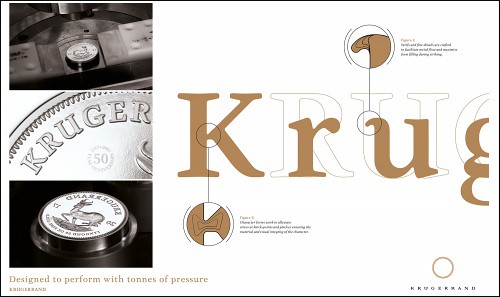
In the medallic arts, additional considerations come into play. The type must convey both the necessary information and the mood of the design, all while being readable at a very tiny size. (For a raft of examples, check out the Twitter hashtag #FontsOnCoins.) In contrast to the Papyrus font blunder in Avatar, the South African Mint announced in August that the font on its silver Krugerrand had won a Craft Award for typography in the Loeries, a renowned series that awards excellence in the communications industry in Africa and the Middle East.
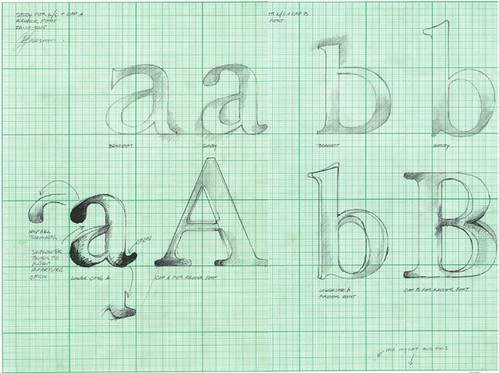
The mint had asked Jan Erasmus, one of the top designers in South Africa, to create a font family for the 50th anniversary of the Krugerrand, the world’s first bullion coin. The new font would be used not only on the coins but on the related marketing materials. Erasmus opted to recut the Krugerrand’s original font, a classic known as “Goudy Old Style.” The result was a medium-contrast set of characters, with soft corners and straight edges for a crisper appearance:
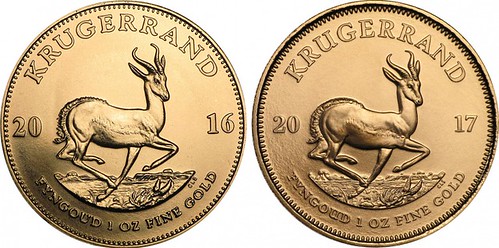
The original and updated typefaces
The apertures (for example, the hollows within the letters “b” and “d”) are more open, to prevent their being filled in by the flow of metal during striking. Pains were taken to ensure the new font could be struck into a planchet at a minuscule 3-point size under 150 tons of pressure.
Erasmus’s attention to detail, consideration for the collector, and creativity not only produced a successful font — which is now seen on millions of 50th-anniversary Krugerrand coins around the world — but earned the South African Mint a well-deserved Craft Award and heaps of praise.
To read the complete article, see:
How fonts can make or break a project, numismatic or otherwise
(http://news.coinupdate.com/how-fonts-can-make-or-break-a-project-numismatic-or-otherwise/)
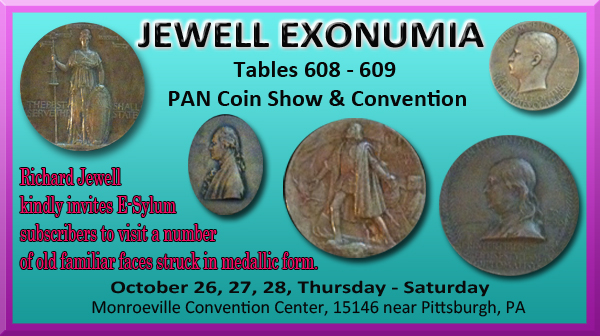
VOCABULARY TERM: MINT SET
Mint Set. A group of related coins, usually of different denominations of the same issue, packaged and sold by the mint that manufactured them or their sales agency. The packaging takes on a certain cachet that makes such set an official issue. The coins, any number from two upwards, are usually uniform as to finish or condition, most often of mint state (uncirculated). Thus mint sets differ from proof sets (see proof surface), and from assembled sets which can be the same issue coins but brought together at a later time. The coins in mint sets are usually of uniform toning in contrast to those in assembled sets (it is said that coins in assembled sets have not “traveled the same road together” and therefore may possibly have different toned surfaces).
There are a number of mint set terms, these are: Special mint set, select mint set or specimen set. Coins for inclusion in the set are better than mint run specimens, care has been taken in selecting the best specimens available. Or some care may be given to either or both dies and blanks. “Specimen set” was used by the Canadian Mint.
Souvenir mint set. A set issued by a mint which contains one or more special commemorative or souvenir coins in addition to regular issued coins.
Uncirculated mint set. Mint run coins sold by the mint or an assembled set, the only difference may be in the packaging.
A year set is not a mint set but is an ASSEMBLED SET which may or may not be privately packaged.
CLASS 11.4
Looking for the meaning of a numismatic word, or the description of a term? Try the Newman Numismatic Portal's Numismatic Dictionary at: https://nnp.wustl.edu/library/dictionary

LEOPOLD HAMBURGER (1836-1902)
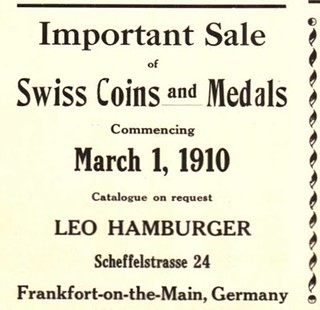 Leopold Hamburger (1836-1902), was born on June 1, 1836 at Hanau am Main, Germany, son of Sephardic Jewish immigrants from Portugal Josef Emmanuel Hamburger and Dorchen Hamburger. He began
his career working for the banking and money exchange brokerage firm which also sold antique coins, J. N. Oberndörffer at Munich, established 1829...
Leopold Hamburger (1836-1902), was born on June 1, 1836 at Hanau am Main, Germany, son of Sephardic Jewish immigrants from Portugal Josef Emmanuel Hamburger and Dorchen Hamburger. He began
his career working for the banking and money exchange brokerage firm which also sold antique coins, J. N. Oberndörffer at Munich, established 1829...
Eventually Hamburger headed the branch office at Vienna, Austria, where he also sold besides antique coins, minerals and other items typical of the old world curiosity cabinet. He established his own concern as early as 1861 in Vienna working as a mineral and coin dealer. In 1864, at the age of 28, he transferred the business opening the coin shop at Frankfurt am Main taking on a partnership with the old time book dealer Hermann Joseph Bäer (1811-1881). In the early days Adolf-Emil Cahn (1839-1918), worked as an apprentice for Hamburger eventually leaving in 1890 to form the House of Cahn at Frankfurt, which competed with Hamburger's establishment.
Franz B. Döpper, Frankfurt und seine alten Firmen (Deutsche Großstädte im Spiegel der Wirtschaftsgeschichte. Band 8, 1991) relates the establishment of various coin firms in Frankfurt. Adolf Hess (1846-1912), moved his shop from Giessen to Frankfurt in 1872 and competed with Hamburger as a numismatic auction house. From 1889-1910 Eugen Seligmann held a coin shop at Frankfurt. Later on Sally Rosenberg opened her shop at Frankfurt in 1899.
Soon after opening shop at Frankfurt Hamburger was recognized as an important numismatist. In July 1869 he traveled back to Vienna to attend the much celebrated auction of the Graf von Klebelsberg collection held by his old acquaintance Georg Kraus. On February 6, 1871, he married Caroline Gutel Rothschild (1849-1925). They had five children : Caecelie (1871-1943), Hedwig (1873-1874), and Joseph (1874-1929); Dorchen (1876-), and Mathilde (1878-). In August 1871 Hamburger and his partner held their first auction. In 1875, his cousin, the 29 year-old Leo Hamburger also joined him in partnership. The firm of L & L Hamburger began publishing the coin journal Allgemeine numismatische Blätter.
As the Frankfurt numismatic market expanded by 1906 the Frankfurter Numismatische Gesellschaft was established. Joseph Hamburger was a charter member of the Frankfurt Numismatic Society.
Joseph Hamburger, Leopold's son and successor was born on September 11, 1874. On July 25, 1907 Joseph Hamburger married Emilie Mases. Leopold Hamburger died at Frankfurt am Main on February 12, 1902, at the age of 65.
Leopold Hamburger was a very devout Jew and loved Jewish history which led him to amass antique Palestinian coins and travel to the Holy Land. At his death he is reported to have owned the largest collection of antique Palestinian coins known. He bequeathed his collection to the British Museum. His expertise on Palestinian coins resulted in two published works, which undoubtedly were inspired by the 1873 seminal dissertation of Eugen Merzbacher. Leopold Hamburger's two studies are : Die Silber-Münzprägungen während des letzten Aufstandes der Israeliten gegen Rom. (Zeitschrift für Numismatik. Berlin, Volume 18, 1892); and, Die beiden palästinensischen Münzstätten Nikopolis-Emmaus.
The firm of L. & L. Hamburger auctioned hundreds of notable collections of European nobles during its 54 years in partnership. For example, in 1875 they auctioned the collection of Count Heinrich Stecki.
To read the complete article, see:
HAMBURGER, LEO
(https://sites.google.com/a/numismaticmall.com/www/numismaticmall-com/hamburger-leo)
The entire inventory of the Lupia Numismatic Library is for sale. Individual items will be available before the remaining archives are broken up into parcels sold at philatelic auctions in the U. S. and Hong Kong. Check NumismaticMall.com frequently as dozens of new items with estimates will be posted daily until everything is sold.
All inquiries will be given prompt and courteous attention. Write to: john@numismaticmall.com .

MORE ON THE RENOVATED MONNAIE DE PARIS
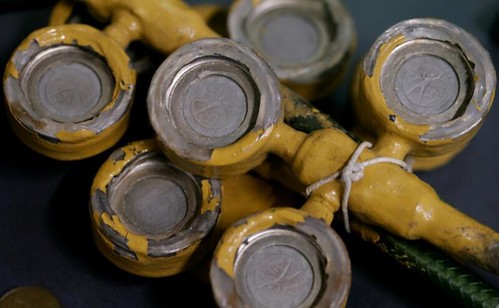
Moulds to manufacture ten French francs
After more than a thousand years of service, the Paris mint has thrown its doors open to the public with a vast exhibition of treasures, collectors’ coins and a view of the craftsmen in their workshops.
On the banks of the River Seine, workers chisel, press and engrave medals and memorabilia in the factory that advertises itself as the oldest in the French capital, with a history stretching back to the year 864.
Since the introduction of the euro in 2002, the mint - or the ‘Monnaie de Paris’ - has passed industrial-scale production of everyday coinage to a plant in the southwestern town of Pessac.
Its workforce, about 150-strong, is now counting on collectors, the curious and tourists to give it a longer lease of life.
“Here we mint coins which still have a value,” the mint’s chief executive, Aurelien Rousseau, said. “But it is indeed more often collectors who are interested in these products.”
Displays include ancient treasure chests, a coin dating back more than 2,000 years and the platinum meter measure that remains the international reference of the metric system.
To read the complete article, see:
Paris mint lures tourists with treasures
(https://uk.reuters.com/article/us-france-coins-museum/paris-mint-lures-tourists-with-treasures-idUKKCN1C01X2)
To read the earlier E-Sylum article, see:
MONNAIE DE PARIS RENOVATIONS COMPLETE (http://www.coinbooks.org/v20/esylum_v20n40a23.html)
WORLD WAR I COMMEMORATIVE SCULPTOR LEROY TRANSFIELD
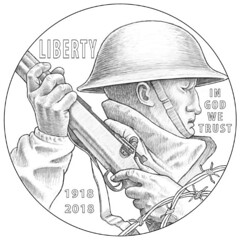

The most common mistake beginners make, contest officials told LeRoy Transfield, is adding too much detail.
So the Orem sculptor meticulously planned every detail of his 8-inch plaster masterpiece: a soldier with a crooked nose clutching a rifle, poppies blooming amid twisted barbed wire, and the words "In God We Trust" square to the soldier's face.
After several weeks of work, Transfield's finishing artwork was chosen as the winning design for the 2018 World War I American Veterans Centennial silver dollar.
"It was really hard to come up with a design," he said, "but in the end, I came up with something I was really happy with. When I sent it off, I didn’t know if it was going to do well or not, but at least it was something I could put my name on."
Although he's never sculpted a coin before, Transfield said U.S. Mint officials unanimously voted for his design among 20 other finalists. The final retail product is only 1 ½ inches wide, featuring Transfield's artwork on both sides of the coin.
The commemorative silver dollar will be released in January, marking the 100th anniversary of the end of World War I. The U.S. Mint plans to strike 400,000 silver coins with Transfield's design.
Art for the front of the coin, "Soldier’s Charge," came easily, Transfield said. After trying a few designs, he decided to feature the profile of a soldier.
"I didn’t want him to look like some model in an artist’s studio," Transfield said. "I made his nose like it might’ve been broken. I wanted to give him a rugged looking face. … I wanted that feeling of combat."
Next he added the rifle and the barbed wire, as well as placing the phrases "Liberty" and the years 1918 and 2018. He also carefully placed the words "In God We Trust" directly in front of the soldier's face.
"He's going right into battle, so I liked having the lettering there," Transfield explained. "When I did that, I could tell that’s it; that’s the front."
The flip side, "Poppies in the Wire," came slowly. The sculptor tried using images of an eagle or a carrier pigeon, but none of the designs fit.
As the deadline neared, Transfield finally settled on the picture of poppies growing among the barbed wire. Both images are common wartime symbols.
When the U.S. Mint approved the design, official artists tweaked the art slightly, adding shading details and making the rifle more accurate for the time period.
"They said, ‘Don’t worry that you don’t know how to make a coin. We just want your ideas,'" Transfield said.
Transfield said he started sculpting as he was a teenager living in New Zealand. After graduating from BYU-Hawaii with bachelor's degree in fine arts, he and his wife moved to Orem, where he operates a sculpting studio out of his garage.
"This is the first time I've had an attempt at a coin, and I'm surprised that I won," he said. "To be able to make a contribution in my own artistic hand, it's great."
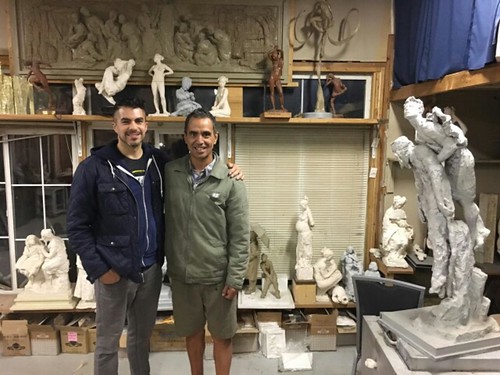
Utah sculptor LeRoy Transfield, right, poses in his sculpting studio in Orem
To read the complete article, see:
Silver dollar artist: Orem sculptor designs WWI commemorative coin
(https://www.deseretnews.com/article/865690697/Silver-dollar-artist-Orem-sculptor-designs-WWI-commemorative-coin.html)
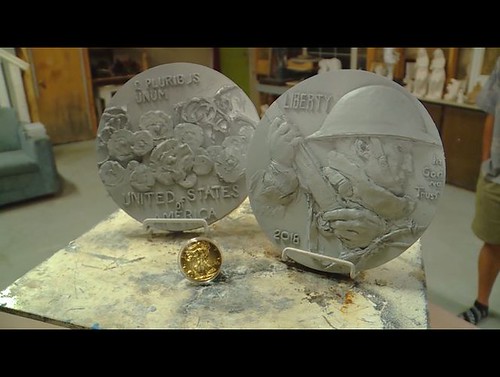
To read the complete article, see:
Silver dollar artist: Orem sculptor designs WWI commemorative coin (https://www.ksl.com/?sid=46108345&nid=148)
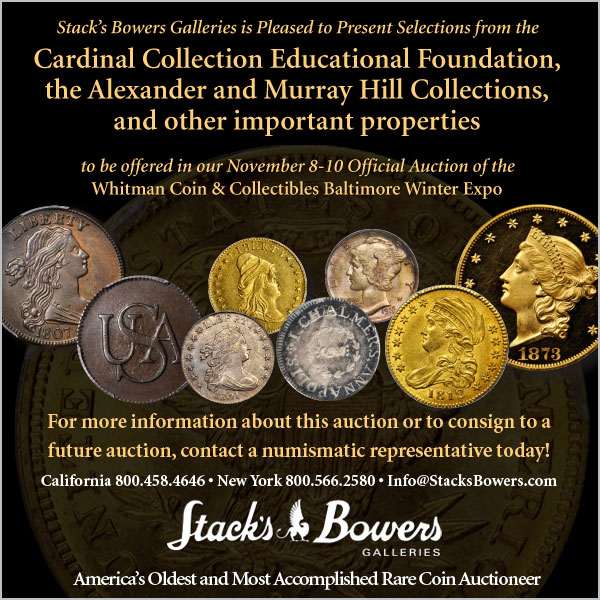
AMERICAN BANK NOTE COMPANY COLLAGES
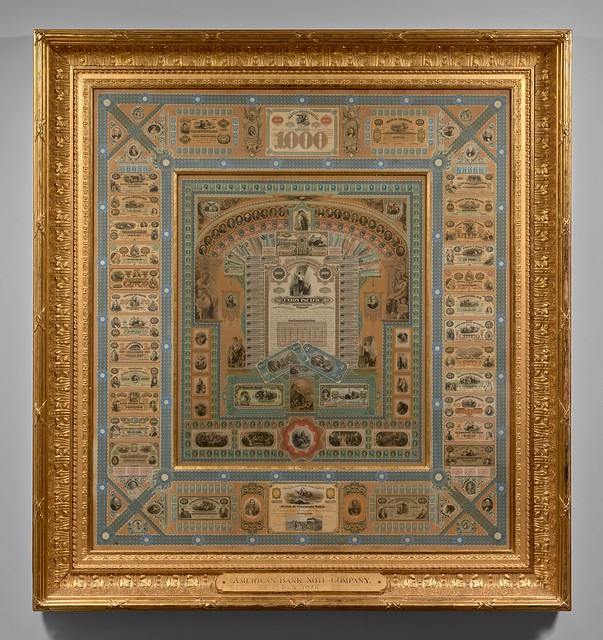
American Bank Note Company Collage, gold frame
A transformative gift, the Susan and John Jackson, B.A. 1967, Endowment Fund for Numismatics, has helped establish an independent Department of Numismatics at the Gallery. The department will also benefit from a generous bequest from Susan and John Jackson, B.A. 1967, and the Liana Foundation, which will considerably augment the department’s collection of paper currency and related artwork.
One of the most impressive pieces is a unique gilded framed currency collage from the American Bank Note Company, dated to the late 19th or early 20th century. The inner center frame is composed of green stamp proofs, including the 1871 6¢ Hawaii stamp, 1883 1¢ Costa Rica stamp, 1885 1¢ Dominican Republic stamp, and 1860–64 8 1/2¢ Nova Scotia stamp. In the center is a Union Pacific stock certificate for 1,000 shares. Above, an arc has 30 1882 Hawaii stamps, alternating between the 10¢ black stamp and the 15¢ brown stamp. Above the first arc, a second arc consisting of 22 oval portraits of notable 19th-century figures adorns the center frame above the stock certificate.
The bottom portion of the central framed area comprises four historical vignettes, which are also found on bank notes and other currency-related material. These include, from left to right: De Soto’s discovery of the Mississippi River; the embarkation of the Pilgrims; the baptism of Pocahontas; and the signing of the Declaration of Independence. Around the center area, a second frame is composed of specimen bank notes of Argentina, Bolivia, Brazil, Chile, Colombia, Montenegro, and Peru. Additional stamps and colored geometric lathework contribute to the vibrant and elaborate collage.
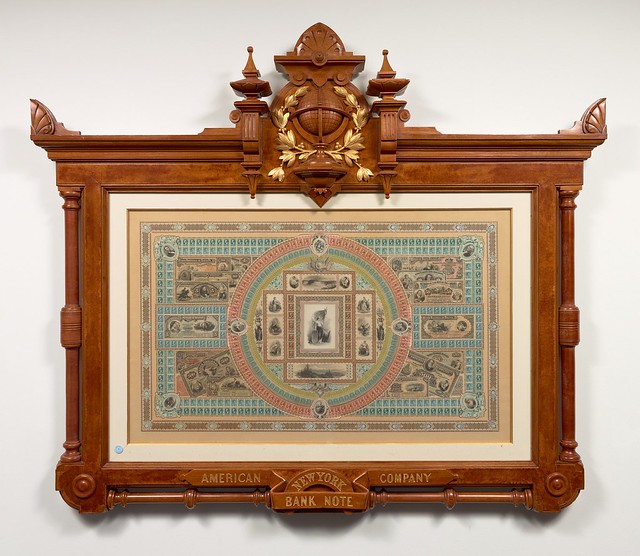
American Bank Note Company Collage, wood frame
To read the complete article, see:
NOTE FROM THE CURATOR (http://artgallery.yale.edu/numismatics)
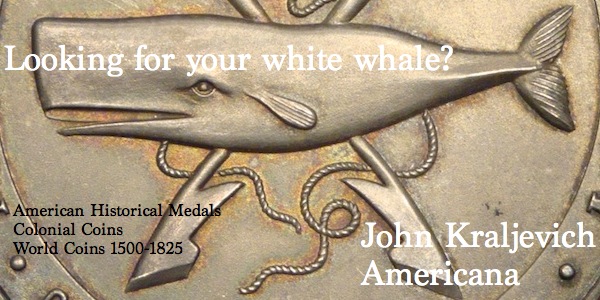
MORE ON THE ORIGINS OF THE CONTINENTAL DOLLAR
German Inscriptions in Book Illustration
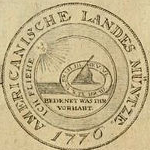
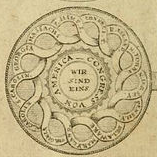
Before someone goes off track and chases a red-herring, be aware that the coin pictured in Allgemeines does not exist. That fact is made in the text, on page 180:
"Damit die Innschriften gleign volle Wirs fung thun mochten, sind fie, zum Behuf des Deutschen Lesers, übersetzt eingetragen."
That means:
"In order that the inscriptions might have full effect, they are, for the sake of the German reader, translated."
If I were researching this, I would not look to London. I have a hard time accepting the fact that anything such as this would be possible in London while we were in the middle of our Revolutionary War with England and also given the fact that all communication was by boat.
26 May 1783 Letter to Franklin
Also, there is the involvement of Benjamin Franklin, who was living just outside Paris during this time. Now, add in the fact that the publishers of Allgemeines wrote to Franklin while he
lived in Paris asking him for illustrations of medals for that book and they then illustrated the Libertas Medal and the Continental Dollar. That's too much of a coincidence to simply ignore.
Berlin on 26 May 1783.
Sir.
With the intention of publishing, towards the end of September, an American Almanac in German for the coming year, and desiring to decorate it with several related prints, the composition of which should not be ideal; it is to you, Sir, and to your wallet, that must be very rich in all that relates to the history of the Anglo-American Colonies which I dare to resort to, although I do not have the honor of You to be known.
Let me briefly describe the plan of this Almanac, and then ask for your gracious assistance, either for information or for the very articles I need, and that no one is better off to provide me that You Sir!
Almanac will contain, in the first place, the history of the Revolution, according to the best Authors and the most veridical opinions which may have been obtained. This subject will be adorned with historical engravings, representing the most remarkable events of this war. In the second place: Gallery of the great men of America, with an account of their political or military career decorated with their portraits, copied from those drawn by Du Simitier at Philadelphia, and others which have appeared in England. Come You hold such a high rank among the great men of America, suffer that I ask you, if your portrait, as it was engraved in 1782 by Pelicier for the Essay on the Anglo-Americans, is enough resembling to serve as a model?
To make this gallery more complete, I would pass from great men to the celebrated men of America, and this is where I am in trouble for the following portraits:
John Adams's picture
" by Sr. Payne, Author of Common Sense
" of Warren, killed in Bunkers Hill
" Montgomery killed in Quebec
" by Sr. Paul Jones Commodore at the service of the 13 United States.
To these portraits I would like to be able to join the following pieces:
Mausoleum ordered by Congress to Dr. Warren.
"ditto" to the memory of Genl. Montgomery.
Medal struck by order of Congress on the occasion of the
of Major André.
"ditto on the occasion of peace to eternize
of the Revolution
Form of the Pappier-monnoye
Coinage with the unifying symbols of the 13 states
The Weapons of the Thirteen States.
The Colored Treasury Pavilion
Uniform of American Troops, namely Regiments Washington and Gates, colorful.
The historical part of this Almanac being entrusted to one of our best historians, Sr. Sprengel, Professor of History at the University of Halle, who possesses the English and all the knowledge and qualities which constitute the good historian, I venture to flatter myself, that his work will deserve your approval. I therefore reserve to myself the honor of presenting him to you, and even through your mediation to the honorable Members of Congress, to whom I wish to pay tribute.
Forgive me, sir, in favor of this idea, that I may interrupt Your grave occupations by a hors d'oeuvre of this kind, and grant me the grace of deferring to my very humble request.
Finally, allow me to add, that the time here, at the end of September, which is fixed for the publication of the Almanacs of our country, is scarcely distant, and the execution of the various engravings requiring considerable time, furnishing as much as possible the materials which are wanting to me, you will add infinitely to the price of the benefit I am soliciting. Bis dat, which cito dat.
May it be lawful for me to show you here the veneration and respect most warmly felt, of which I am penetrated for the Philosopher and the statesman, that the two hemispheres in You! It is in these sentiments that I have the honor to be Monsieur Your very submissive and obedient
Charles Spener
Bookseller Image
Endorsed: Charles Spener 26 May 1783
To read the complete letter, see:
From Charles Spener (unpublished) Berlin ce 26. May 1783.
(http://www.franklinpapers.org/franklin//yale?d=662251423&vol=39&page=533)
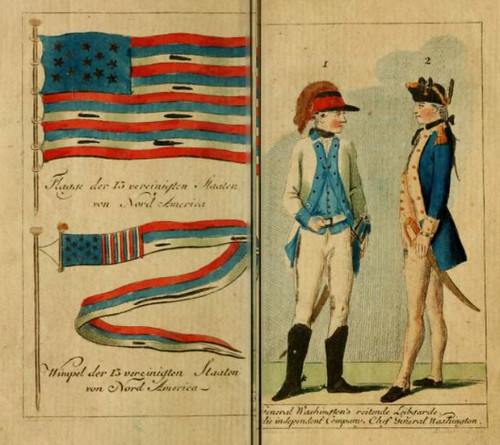

Sarah Banks Catalogue Advertisement
I'm a little surprised that no one has yet mentioned the paper by Catherine Eagleton published in The Numismatic Chronicle for 2014, "Collecting America: Sarah Sophia Banks and the 'Continental Dollar' of 1776," pp. 293-301. Ms. Eagleton argues "that the piece may never have been intended as a coin at all, not struck in America, or even made in 1776."
She bases her conclusion on the catalog of the Sarah Sophia Banks collection, now in the British Museum: in the 1815 version of this catalog, following the entry for "Congress Dollar. 1776. never current, struck on speculation in Europe, for sale in America" appears an advertisement pasted in the catalog after the entry:
Six-Pence Each.
N. B. Representing the Paper Currency of a Dollar, which goes for
Four Shillings and Six-pence in that Country.
E X P L A N A T I O N.
The Thirteen Colonies united like a Chain, with the names of each
in the Ringlets, the Words, "AMERICAN CONGRESS" within,
in the Center, "WE ARE ONE," and with Rays of the Sun
fhooting to each Ringlet, as a Glory.
The Reverfe is the Sun going round its Orbit, with a Motto
"FUGIO," fignifying, I fly: under the Dial is "MIND YOUR BUSI-
NESS." The Date, 1776, is the time they declared Independency.
The Letters, E. G, FECIT, its maker's Name.
Ms. Eagleton did not have the benefit of Eric P. Newman and Maureen Levine's article "18th-Century Writings on the Continental Currency Dollar Coin," The Numismatist July 2014, pp. 34-57, because she mentions "contemporary references confirming that the Continental Dollar was made before 1786" (p. 299). In fact, as Eric and Maureen have pointed out, crediting me for the discovery, the Continental Dollar was mentioned in a poem published in New York November 6, 1779 and illustrated as early as 1784.
The advertisement is new to me, however. My own opinion (as of now) is that the Continental Dollars were originally coined in 1776-78 as speculative patterns in the hope of obtaining a coinage contract, but the effort died, the Continental Congress never going so far as even to appoint a committee to study the matter. But it has always seemed as though there are too many of them around in uncirculated condition for this purpose, and it would now appear that some dies were taken to England after the Revolution (the Continental Dollar is listed in a catalog of the Banks collection made "in or before 1790") and copies restruck there.
(Note: the omission of the dollar denomination from the paper money emission of July 22, 1776, continuing to January 14, 1779, is NOT evidence that the Continental Dollar was intended to fill the gap; there was already a dollar coin in circulation, the Spanish Milled Dollar.)
It seems clear to me that at least SOME "1776" Continental Dollars were struck in London in 1783; this fits well with Du Simitiere's statement and the first illustration in 1783, plus the Banks Collection example.
Rivington’s Gazette Poem, Nov. 6, 1779
Congress will nobly pay him for his pains,
Of pewter dollars what both hands can hold;
A thimble full of plate, a mite of gold;
The lands of some big Tory he shall get,
And strut a famous col’nel en brevet,
And last to honor him, (we scorn to bribe,)
We’ll make him chief of the Oneida tribe.
Tom Wetter adds:
it doesn't say continental dollars, it says pewter dollars. Reading back through it I don't think it's very applicable here. I have a book from 1769 with a similar reference to 'pewter dollars' and the only thing it does prove is that that term was in use before 1776, and, it could discredit that poem.
The Congratulation (http://www.historycarper.com/1779/11/06/the-congratulation/)
The advertisement describes the 1776 date as "the time they declared Independency." To me, this implies that 1776 was NOT the actual date they were struck; at least not the examples offered in this advert.
Is that the earliest reference we're now aware of? Bob Leonard provided the following summary of events. -Editor
1. Du Simitiere wrote, in 1783 or 1784, that the Continental Dollar was "Struckt in London on Type-Metal, and dated 1776." (Orosz, pp. 26-7)
2. The earliest illustration of a Continental Dollar appears IN EUROPE in late 1783.
3. The Sarah Sophia Banks collection of London contained thousands of coins by 1791. Circa 1815, her Continental Dollar was cataloged as "Congress Dollar. 1776. never current, struck on speculation in Europe, for sale in America." An accompanying ad offers them for sixpence each, adding "The Date, 1776, is the time they declared Independency. The Letters E. G. Fecit, its makers Name."
4. No record authorizing it has been found in the papers of the Continental Congress for 1776.
5. In Boston, the January 1, 1789 issue of the Independent Chronicle and the Universal Advertiser denied that there ever was such a coin as the Continental Dollar. Likewise, on February 21, 1790, Paul Revere wrote, "as for pewter money struck in America, I never saw any, and I have made carefull (sic) inquiry" (both citations from Newman and Levine, p. 50).
Were this any other coin, we would have no hesitation in attributing it to European speculators in 1783, a time when a U.S. coinage was being seriously considered (the Nova Constellatio coppers were issued that year).
Against this attribution is the reference in the satirical 1779 poem to Congress paying "pewter dollars," but perhaps this should not be taken literally.
Also, in 1911, Gallaudet family historian Edward Miner Gallaudet informed a relative that EG FECIT stood for 18th-century New York engraver Elisha Gallaudet (Newman and Levine pp. 51-2). While Elisha Gallaudet is chronologically possible for 1783 as well as 1776, and the Continental Dollar dies COULD have been engraved in New York for striking in London, he offered no evidence and this could merely be wishful thinking. Engravers with the initials E G should be looked for in England.
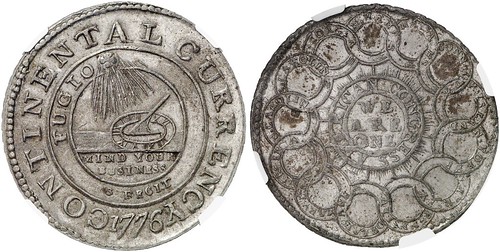
To read the earlier E-Sylum articles, see:
ON THE ORIGIN OF THE CONTINENTAL DOLLAR (http://www.coinbooks.org/esylum_v15n44a11.html)
ON THE ORIGINS OF THE CONTINENTAL DOLLAR (http://www.coinbooks.org/v20/esylum_v20n40a13.html)
NOTES ON THE ORIGINS OF THE CONTINENTAL DOLLAR (http://www.coinbooks.org/v20/esylum_v20n41a16.html)
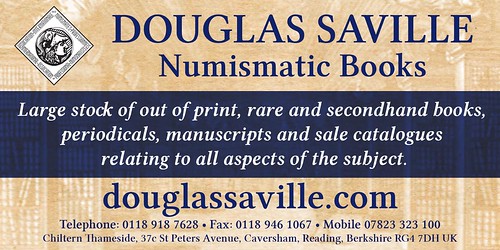
THE CURIOUS BOGGS ONE EURO NOTE
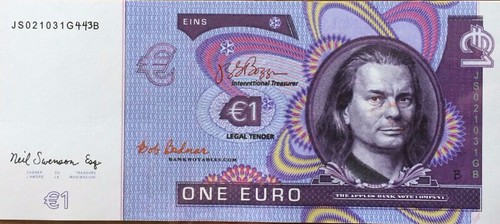
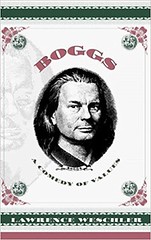 This item appeared on eBay last weekend. Although I knew "Money Artist" J.S.G. Boggs and had spoken to him not long before he died, I'd lost touch with him for many years. I
wasn't aware of this note and it raised some questions. A lot of the elements seem genuine Boggs, but the portrait here is not by him - BEP artist Tom Hipschen did that for a book cover: Lawrence
Weschler's BOGGS: A Comedy of Values.
This item appeared on eBay last weekend. Although I knew "Money Artist" J.S.G. Boggs and had spoken to him not long before he died, I'd lost touch with him for many years. I
wasn't aware of this note and it raised some questions. A lot of the elements seem genuine Boggs, but the portrait here is not by him - BEP artist Tom Hipschen did that for a book cover: Lawrence
Weschler's BOGGS: A Comedy of Values.
I first reached out to Steve Davis of Numismatic Auctions LLC, who has sold Boggs works in his sales.
Steve Davis writes:
I have not seen this note before. I remember Boggs showing me the actual portrait engraving Hipschen did of him once, it was really nicely executed; now that is an item I wish I had. I just got two or three other unusual Boggs items offered to me as well, which seems to happen every time I sell one at auction. It will be a curiosity to see what happens with all the material in Boggs's studios.
A URL is listed on the note: http://banknotables.com/ . The Naples Bank Note Company (NBNC) sells high-quality fantasy banknotes for fundraising and souvenir purposes. It's Bob Bednar's company, and his name is on the note, too. A security paper executive, Bob is a member of the International Bank Note Society (IBNS) and the Society of Paper Money Collectors (SPMC). He's also an E-Sylum subscriber, so I reached out to him next.
Bob Bednar writes:
NBNC was formed in order to obtain part of the European Bank printing contract. Utilizing some ex-United States Banknote Company personnel, the One Million Euro Commemorative was designed and printed in order to demonstrate that a US Security printer could provide the quality of a banknote printer.
I also provided special security paper to Boggs for years.
The piece is a Naples Bank Note design that Boggs showed me at the Orlando airport. He altered our One Million Euro note design and forged my signature. He made subtle changes to the note. For example, using "Apple Bank Note Company" instead of "Naples Bank Note Company".
Boggs included a front to back Register Mark in his design. On our website we purposely left out that security feature to be able to readily identify counterfeits. Basically it is a symbol, like a star on our note, that color is filled in on one side and no color on other side. It's located above the Treasurer's signature.
I thought Boggs had the piece so I'm not sure how it got on eBay.
Here's the original One Million Euro note (sans Register Mark):
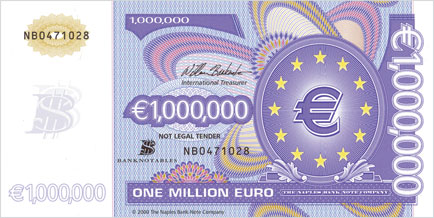
When Boggs made his "Boggs Bills", he would draw an original, scan it into his computer at high resolution, then use editing tools to refine or add design and security features. He would print limited runs at high resolution, then destroy his files. For this note, I imagine he used a similar process.
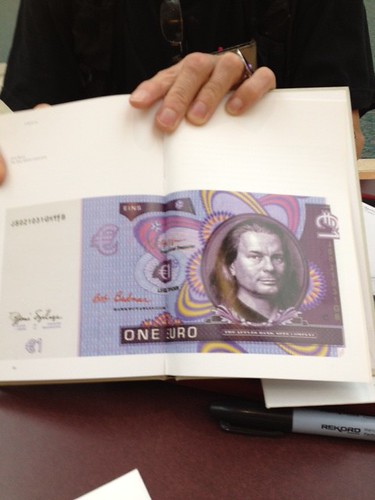
Boggs showing his new version of the Euro note
Image courtesy Bob Bednar
Part of the serial number is added by hand: "443". So how many of these were made - 500? 1,000? Any information would be appreciated.
Craig Whitford writes:
I'm not aware of how this Euro note came about. I was with Boggs and Tom Hipschen at the meeting and handshake agreement to produce the engraving during the FUN convention in 1996. The casual meeting was held on 1/8/1996 at The Peabody. It was early in the morning. Boggs conducted the deposit on the transaction with a $1000 Project Pittsburgh note titled "Down Payment on a Portrait". The final transaction was paid for in Boggs Bills.
As I recall the engraved plate wasn't completed until 1998. I remember seeing the final plate and some Spider-Press prints from the plate in various colors. It was always Boggs' intention to have an engraved note produced with his portrait. The only image I was aware of utilizing this portrait was on the book.
Since Boggs' passing, collectors should be careful about unusual items offered relating to Boggs work. His work was counterfeited while he was alive by those hoping to make a quick profit.
Tom Hipschen writes:
It's fun to see an artist friend enjoying an afterlife.
Boggs would call me once in a while or visit me while traveling through Washington, but I never saw him more than once or twice a year. He wanted me to partner with him on many projects, but I was reluctant to put that much time into things that were essentially his artwork, not mine.
He pitched the portrait project many years ago as an exchange of artwork. I was never paid directly for it. I put in several hundred hours, and today creating something like that would cost $20,000 to $30,000. He pitched it at the time as an entry that I might make into the world of fine arts as I was looking towards retirement from my government job. There were other money artists involved, and there were several pieces of his own artwork created that included my name and even fingerprints. He even had a gallery arrangement in Florida. I probably never realized more than a couple of thousand dollars from any of it.
I hand printed working proofs and a few final proofs of my engraving for him on my own press at home utilizing security paper provided to him by Bob Bednar. It is a hand engraving made in the banknote manner on a piece of steel that was large enough to print a whole US Banknote sized piece of paper without showing a plate mark. He told me that the few prints that I gave him would go to his lawyers who were preparing a Supreme Court case to try and retrieve many of his artworks that were seized by the US Secret Service. Of course that challenge never went anywhere, and I heard no more of it. I assumed because of the paper size that he intended to paint or print artwork around my engraving to create some of his notes. I never saw the results.
I met Lawrence Weschler once at a book signing, and I was surprised to see the portrait appear on the cover of his book. I was never paid for that, either. I assume that Boggs gave it to him.
I unfortunately know nothing about this particular note. Is the portrait on this note printed in intaglio? If so, it would probably have been created with one of the proofs that I gave him. I assume not, as I once heard him tell another collector that the original engraved plate had been lost. I'm not sure why he maintained that.
As to using himself on his notes, I remember that one of his many ideas years ago was to create a series of bank notes similar in design the the US currency but different in every detail featuring artists for the portraits to be released at the face cost of whatever denominations the artists themselves would choose. For that program he wanted to use his own portrait on the $1 denomination so it would be the most common and available to anyone. I was still working at the BEP at the time. Such a thing would have been unthinkable for me then. Many friends there could not conceive how I could even talk to Boggs, let alone play with him in these artsy fashions.
Author and researcher Neil Shafer recently published Part One of a great article on J.S.G. Boggs article in Bank Note Reporter. He writes:
Thanks for writing about this unusual piece- not that they are not ALL unusual, just that this represents his attempt at keeping up with monetary events like the Euro. I had never seen or heard of anything like this coming from him.
Neil kindly provided an image of one other Boggs bill he incorporated his own portrait into. Thanks!
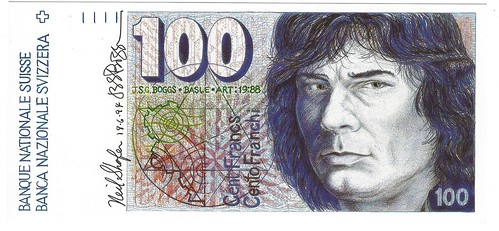
Thanks, everyone. It's fabulous to have some many knowledgeable folks chime in on a topic like this - it's The E-Sylum at its best.
To read the complete eBay lot description, see:
J S G Boggs "One Euro" - 443 (http://www.ebay.com/itm/J-S-G-Boggs-One-Euro-443-/322791690083)
Here's another eBay Boggs lot: J S G BOGGS TRANSACTION WITH 2 NOTES AND RECEIPT (http://www.ebay.com/itm/J-S-G-BOGGS-TRANSACTION-WITH-2-NOTES-AND-RECEIPT/131178980175)
For more information on the One Million Euro notes, see:
One Million Euro Banknotables?Press Sheets (http://www.banknotables.com/eurobanknotables.html)

RICHARD JEWELL EXONUMIA AT PAN SHOW
Later Rich turned his attention to medals, assembling another top-notch collection which he often exhibited from at Pennsylvania Association of Numismatists (PAN) shows. Now he's cutting back on his collections and taking a couple tables at the upcoming PAN show to sell some of his accumulations. At my request he provided images of a few selected pieces. Pictured at right just below is the First Transatlantic Flight medal by Julio Kilenyi (101.7 mm). -Editor
I will have a booth at the PAN Fall Show and Convention, October 26, 27 & 28th at the Monroeville Convention Center, outside of Pittsburgh, PA. At booth # 608 & 609 you’ll be able to see some of Julio Kilenyi’s major medallic issues along with Mr & Mrs. James Earle Fraser’s works in bas relief, they will also be joined by works from Emil Fuchs, John Flanagan, Victor David Brenner, Donald De Lue and a few more artists from Europe.
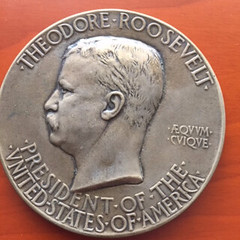
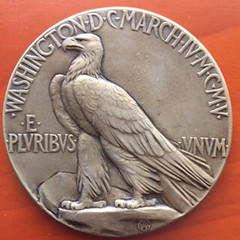
T. Roosevelt 2nd inaugural medal, 1905,
by Augustus Saint-Gaudens and A.A.Weinman,
bronze, 74mm, Tiffany& Co.
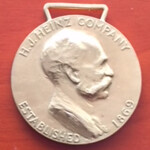
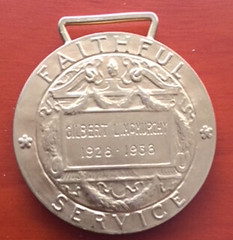
H. J. Heinz Faithful Service Gold Medal FOB, 1-1/4 by Emil Fuchs
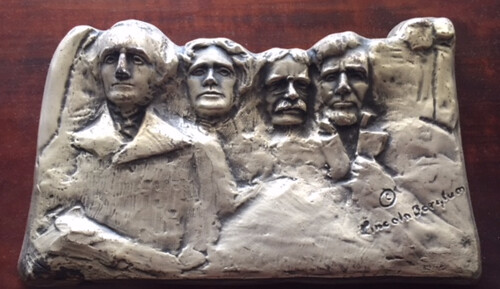
Lincoln Borglum, Mount Rushmore plaque, silver,8” mounted on wood


Left: Extremely rare bronze medallion “Benjamin Franklin, Nini 1779, 5-3/4”
Right: Theodore Roosevelt plaque by Victor David Brenner, 6-3/4”x 4-3/4”
Rich adds:
There could even be some ancients (Greek, Roman, Byzantine) available, not to mention a few Saints may be hanging around! Oh did I forget to mention pirate gold, or more historically correct, shipwreck pieces. The holidays are coming soon- so spend some time at the PAN Fall Show !
For more information on the PAN show, see:
https://pancoins.org/
NUMISMATIC NUGGETS: OCTOBER 15, 2017
DeFleury at Stony Point Obverse Cliche
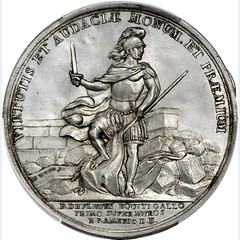

Extremely Rare DeFleury Obverse Cliche
By Pierre-Simon-Benjamin DuVivier
"1779" (1789) DeFleury at Stony Point Obverse Cliche. Tin, uniface, backed with paper. As Betts-566. MS-62 (PCGS).
Personally produced by the hand of DuVivier, the Paris engraver who was contracted by Augustin Dupre to create several of the Comitia Americana medals, this piece was created from a pre-completion state of the obverse die. The exergual legend is rendered with different lettering in the third line (R.P. AMERIC. D.D. instead of RESP. AMERIC. D.D.) versus the struck silver and bronze examples, though this state also produced the only other obverse cliche known to us, offered as lot 201 in the 2006 Ford XIV sale.
DeFleury was a French engineer and one of three soldiers awarded medals by the Continental Congress for the Stony Point action that took place on the banks of the Hudson River in July 1779, the others being Anthony Wayne and John Stewart. All three of the Stony Point medals are rare to extremely rare in original form. The John Stewart is uncollectible, with just two known and only one in private hands. The Anthony Wayne is nearly as rare, though Wayne's own gold medal survives. The DeFleury may have a total population of 15 or so, most of which are bronze. The population in tin, as here, is roughly half of that of silver and a tiny fraction of the number of bronzes, making it the most elusive form of this rarity.
Provenance: From the Cardinal Collection Educational Foundation. Earlier from the Cardinal Collection Educational Foundation. Earlier discovered in France in 2013; acquired from John Kraljevich Americana.
To read the complete lot description, see:
"1779" (1789) DeFleury at Stony Point Obverse Cliche. Tin, uniface, backed with paper. As Betts-566. MS-62
(https://auctions.stacksbowers.com/lots/view/3-8O9NT)
1909 Alaska-Yukon-Pacific Exposition Token

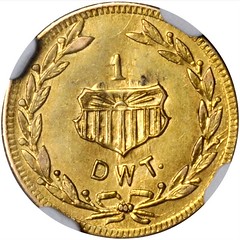
Hart's Coins of the Golden West. 1909 Alaska-Yukon-Pacific Exposition. 1 DWT. MS-62 (NGC).
1.53 grams.
Provenance: Acquired from Moneta, St. Cloud, Minnesota, date not recorded. Company tag included.
To read the complete lot description, see:
Hart's Coins of the Golden West. 1909 Alaska-Yukon-Pacific Exposition. 1 DWT. MS-62 (NGC).
(https://auctions.stacksbowers.com/lots/view/3-8PSJW)
Standing Liberty Quarter Lookalike Medal

To read the complete lot description, see:
Lot 25: UNUSUAL QUARTER MEDAL (https://www.invaluable.com/auction-lot/unusual-quarter-medal-1184C72AF6)
1939 Czechoslovakia Must Be Free Medal


his dramatic medal depicts a Czechoslovakian soldier manacled to two pillars emblazoned with swastikas and encircled by serpents while his family tries to comfort him. The reverse features the National arms and the date of the Nazi occupation, March 15, 1939. These medals were produced to raise money for the Czechoslovakian Pavilion at the 1939 World's Fair held in New York, as funds for the project ceased when the nation was occupied by Germany. The exhibit was finally completed, but not until the fair had been in operation for a month.
Provenance: From the Henry Edward Collection.
To read the complete lot description, see:
Lot of (5) 1939 Czechoslovakia Must Be Free Medals. Bronze. 38mm. (NGC). (https://auctions.stacksbowers.com/lots/view/3-8PGYE)
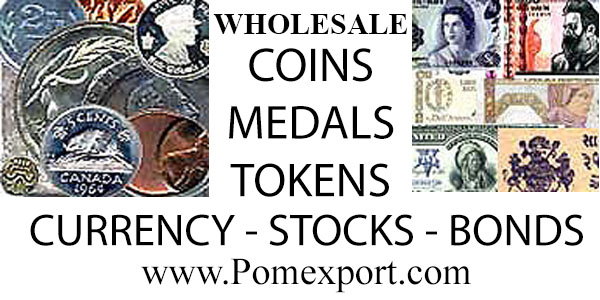
MISSOURI RARITIES IN NEWMAN PART VIII
Some of the most intriguing Missouri notes and documents ever offered at public sale are now available for online bidding at HA.com/3547 prior to the November 1-2 sale at the Heritage Auctions headquarters in Dallas. Eric’s magnificent $10 St. Louis Demand Note (discussed in last week’s issue) provides a segue between Session 1 and Session 2, which is completely dedicated to his Missouri material. Some highlights from the second session are outlined below.
Lot 28321: Pre-Banking Bon Scrip
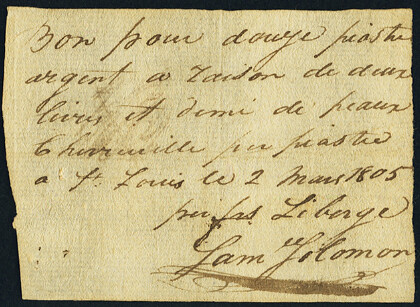
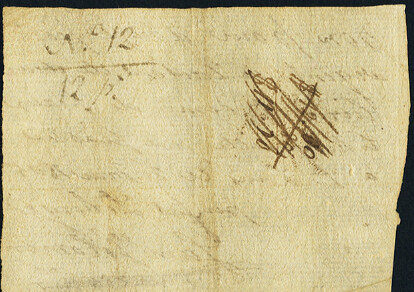
Pre-Banking Bon Scrip: The Newman Collection 12-piastre note issued by Samuel Solomon is one of three “bon scrip” notes in the sale. Before banks came into existence in the Missouri frontier, handwritten notes payable in “current money” of furs and peltries served as a circulating medium to facilitate commerce. To our knowledge, these bons have never appeared at auction. This example is plated in the fifth edition of Eric’s reference, The Early Paper Money of America.
To read the complete lot description, see:
(Upper Louisiana) - Sam'l Solomon "Bon Scrip" for 12 Piastres or Equivalent in Deerskins to Francoise Liberge St. Louis March...
(https://currency.ha.com/itm/obsoletes-by-state/mixed-states/-upper-louisiana-sam-l-solomon-bon-scrip-for-12-piastres-or-equivalent-in-deerskins-to-francoise-liberge-st-louis-march/a/3547-28321.s?type=surl-3547--28321&short=3547*28321)
Lot 28355: Territorial Bank “Beaver Bill”
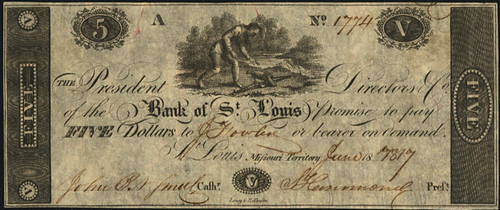
Territorial Bank “Beaver Bill”: As westward migration increased, so did the commercial activity in the Missouri Territory, and the bon scrip system was insufficient to sustain economic growth. St. Louis co-founder Auguste Chouteau provided the impetus for the establishment of the Bank of St. Louis (plagued by delays) and the Bank of Missouri (whose notes he signed as founding president). The Bank of St. Louis 1817 $5 engraved note offered in this sale displays the iconic beaver-trapping vignette engraved by Leney & Rollinson, indicative of the fur trade’s importance in the origins and economy of the city.
To read the complete lot description, see:
St. Louis, Missouri Territory - Bank of St. Louis (1st) $5 June 18, 1817 MO-45 G24. PCGS Very Fine 35 Apparent. . ....
(https://currency.ha.com/itm/obsoletes-by-state/missouri/st-louis-missouri-territory-bank-of-st-louis-1st-5-june-18-1817-mo-45-g24-pcgs-very-fine-35-apparent/a/3547-28355.s?type=surl-3547--28355&short=3547*28355)
Lot 28386: Unconstitutional Missouri Loan Office Note
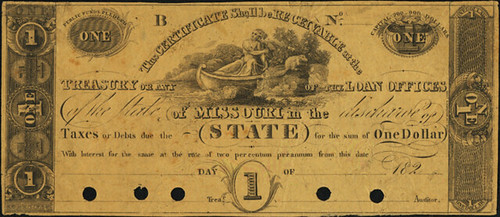
Unconstitutional Missouri Loan Office Note: The failure of the two territorial banks led the government of Missouri to attempt to fill the currency void by issuing loan office notes (which were intended to act as currency without technically being “bills of credit”).
Like the Bank of St. Louis note above, the early 1821 State of Missouri Loan Office $1 proof also features a beaver, further testifying to the significance of the fur trade.
Beautifully engraved and showing the Missouri imprint of Harrison, this proof is considered unique. Like many other notes offered here, it has been in the Newman Collection for over 75 years and has never before been cataloged for sale. This series is fascinating as the issuance of the notes by the State was ruled unconstitutional in 1830 by the United States Supreme Court.
To read the complete lot description, see:
(St. Charles), MO - Treasury or any of the Loan Offices of the State of Missouri $1 at 2% per Year (Act of June 27, 1821) 182...
(https://currency.ha.com/itm/obsoletes-by-state/missouri/-st-charles-mo-treasury-or-any-of-the-loan-offices-of-the-state-of-missouri-1-at-2-per-year-act-of-june-27-1821-182/a/3547-28386.s?type=surl-3547--28386&short=3547*28386)
Lot 28390: Bank of the State of Missouri Issue
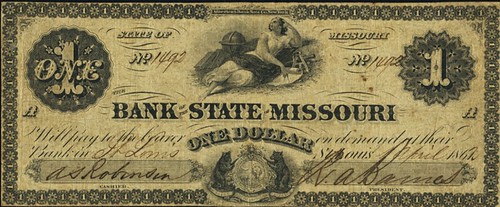
Bank of the State of Missouri Issue: The stalwart Bank of the State of Missouri, chartered in 1837 as the official bank for the state, was a model of soundness even through difficult economic periods. It was rechartered by the Act of 1857, along with several other banks, and lasted until its 1866 conversion to a national bank. Eric’s 1862-dated $1 note from the Bank of the State of Missouri is signed by Robert A. Barnes as president.
Just prior to the battle of Ft. Sumter, Barnes met with Governor Jackson and banking commissioner Sterling Price to move bank funds into pro-secessionist hands. Despite this, his wealth and stature allowed him to remain head of the bank in Union-held St. Louis during the war, and his fortune generously established Barnes Hospital in St. Louis.
To read the complete lot description, see:
St. Louis, MO - Bank of the State of Missouri, Bank in St. Louis $1 April 1, 1862 MO-60 G26 SENC. PCGS Fine 15. . ....
(https://currency.ha.com/itm/obsoletes-by-state/missouri/st-louis-mo-bank-of-the-state-of-missouri-bank-in-st-louis-1-april-1-1862-mo-60-g26-senc-pcgs-fine-15/a/3547-28390.s?type=surl-3547--28390&short=3547*28390)
The Selections from the Eric P. Newman Part VIII sale promises to be a historic numismatic event, and items in all price ranges and interest areas from the 18th to 20th centuries are now open for bidding. Please visit HA.com/3547
NEWMAN PART IX SALE HIGHLIGHTS
 We are pleased to announce our ninth presentation of selections from the incomparable Eric P. Newman Collection. Both currency and U.S. coins from the Eric P. Newman Collection highlight
Day One of our three-day Signature Auction, to be held November 1-3 at Heritage's World Headquarters at 3500 Maple Avenue in Dallas.
We are pleased to announce our ninth presentation of selections from the incomparable Eric P. Newman Collection. Both currency and U.S. coins from the Eric P. Newman Collection highlight
Day One of our three-day Signature Auction, to be held November 1-3 at Heritage's World Headquarters at 3500 Maple Avenue in Dallas.
Currency items start the day on Wednesday, November 1, while U.S. coins follow in the evening session. As always, the scope, quality, and numismatic significance of the Eric P. Newman Collection is on full display. Most of the coins are making their first appearance at auction in nearly 70 years, and some pieces have never before been offered in a public sale.
Such is the case with the 1861 Original Confederate half dollar , which headlines our Dallas event as lot 15125. It is in its first public appearance, having traded hands only by private treaty among some of the finest collections of all time, including the "Colonel" Green Estate, from which it was acquired by B.G. Johnson and Eric P. Newman. Graded PR40 NGC with CAC endorsement, it is one of just four pieces struck (three available to private collectors) and one of the greatest rarities in all of numismatics. Arguably, an Original Confederate half dollar is even rarer and of greater historic significance than a 1913 Liberty Head nickel (as Mr. Newman knows, having owned all five of the 1913 nickels at one time).
Other important coins in the Dallas event include many rare and memorable Colonials, high-value early copper and silver type, and elusive Territorial Gold pieces. A large number of lots will be offered in the online Signature Internet Session to be held on Friday, November 3. There, they present a wonderful opportunity for collectors of all budgets to obtain coins with the prestigious Eric P. Newman pedigree.
Highlights of this offering include coins such as these:
- Undated New Yorke Token, Brass, W-1705, R.6 VF35 NGC
- 1737 Higley Copper, CONNECTICVT, Freidus 1.3-A, W-8215, R.7, Fine 15 NGC
- 1793 1C Chain, AMERI., S-1, B-1, XF45 NGC. CAC
- 1792 Half Disme, Judd-7, Pollock-7, XF40 NGC. CAC
- 1796 25C B-1, MS64+ NGC. CAC
- 1797 50C O-102, T-2, AU55 NGC.
- 1796 Draped Bust Dollar, Large Date, Small Letters, B-5, BB-65, MS63 NGC
- 1796 $2 1/2 No Stars on Obverse, BD-2, AU55 NGC
- 1795 $5 Small Eagle, BD-3, MS64 NGC. CAC
- 1861 Confederate States of America Cent, Original, B-8005, PR63+ NGC. CAC
As in the previous auctions, items sold are from the extensive collection of Eric P. Newman Numismatic Education Society (a Missouri not-for-profit corporation), which has been assembled over a period of 90 years. Proceeds of the sale of all items will be used exclusively for supplementing the Society's museum operations and scholarly numismatic research efforts and for the benefit of other not-for-profit institutions selected by Eric P. Newman Numismatic Education Society for public purposes.
This auction will open for bidding soon at
www.HA.com/coins.To read the complete issue, see:
October 10, 2017 (https://coins.ha.com/heritage-auctions-newsletter/coin-news-eric-p.-newman-auction-part-ix-opens-for-bidding-soon.s?id=5388)Follow the links to see all the highlighted lots. Here are two that particularly caught my eye. -EditorLot 15102: 1795 BD-3 Small Eagle Five Dollar
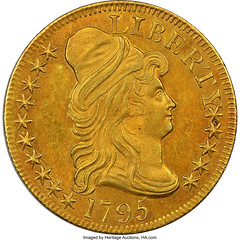
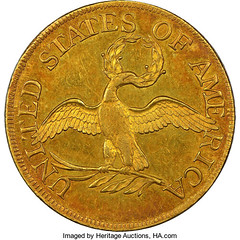
Half eagles were the inaugural gold coinage of the United States Mint, the first delivery from the Coiner occurring in July 1795. During the remainder of the year and likely leading into the first deliveries of 1796, the Mint used eight obverse and nine reverse dies to strike 1795-dated half eagles. A combined 12 different die varieties were created.
Early numismatists such as John C. Randall, William H. Woodin, and Edgar Adams studied half eagle die varieties as early as the 1880s. Randall's collection (W. Elliot Woodward, 6/1885) included seven different 1795 Small Eagle die combinations. In the preface to the catalog, Woodward wrote:
"The silver Dollars, Half Dollars and Quarters, and the early gold represent nearly every known die and combination of dies. In this respect the collection is in the first rank, and it may be said 'it is first, and there is no second.'"
Randall was a mentor to Woodin in studying early half eagles by die variety. Woodin's half eagle exhibit at the 1914 ANS Exhibition included 11 different die combinations of the 1795 Small Eagle; the variety not represented was BD-11, of which only 3-5 pieces are known today. The early half eagle variety studies of Woodin and Adams were influential in shaping the acclaimed die and die state analysis performed by Harry W. Bass, Jr., which is presented in detail in John Dannreuther's reference Early U.S. Gold Coin Varieties (2006).
To read the complete lot description, see:
1795 $5 Small Eagle, BD-3, High R.3, MS64 NGC. CAC.... (https://coins.ha.com/itm/early-half-eagles/1795-5-small-eagle-bd-3-high-r3-ms64-ngc-cac/a/1260-15102.s?ctrack=200071&type=around1-1-coin--news--tem101017)Lot 15124: Confederate States of America Cent
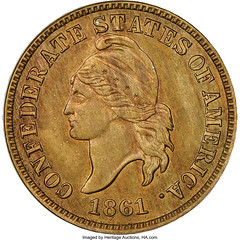
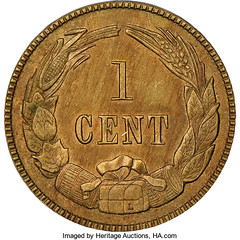
Design and Striking of the Confederate Cent
No official documentation on the striking of the Confederate cents has ever come to light, and we have only second-hand testimony about their creation from the man who actually struck the coins. Fortunately, much has been learned from contemporary numismatic accounts and the evidence of the coins themselves. It seems that in the short window of time between the secession of South Carolina in December 1860, and the beginning of actual hostilities, Philadelphia die sinker Robert Lovett received a commission from Southern sympathizers to produce a design for a Confederate cent. The commission may have come through the jewelry firm of Bailey & Co., or Lovett may have conceived the project on his own, as his work was well-known in the South. In any case, he proceeded to cut the dies and strike a small number of specimens for demonstration purposes in the early part of 1861.The obverse die features a bust of Liberty, wearing a Phrygian cap with a band of six stars in the center, with the legend CONFEDERATE STATES OF AMERICA around, and the date below. The bust is from the same punch used on a store card Lovett issued the year before, making it easy for contemporary numismatists to identify the design as Lovett's work. The reverse includes the denomination in the center, surrounded by a wreath of agricultural products from the South, with a prominent cotton bale at the bottom. Lovett's initial "L" is inscribed on the lower right portion of the bale. The coins were supposedly struck on copper-nickel planchets, but the exact composition has recently been questioned by some researchers who doubt such planchets were available at the time.
To read the complete lot description, see:
1861 1C Confederate States of America Cent, Original, B-8005, PR63+ NGC. CAC. ... (https://coins.ha.com/itm/confederate-states-of-america/1861-1c-confederate-states-of-america-cent-original-b-8005-pr63-ngc-cac/a/1260-15124.s) Paul Williams of Holabird Western Americana Collections submitted this note about an interesting item (lot 3138) in the firm's upcoming October sale. Thanks. -Editor
Paul Williams of Holabird Western Americana Collections submitted this note about an interesting item (lot 3138) in the firm's upcoming October sale. Thanks. -Editor
The Pony Express Memorial Association re-enacted the 1861 record ride of the Pony Express which carried President Lincoln's inaugural address to California. The 1923 ride was made by numerous teams, all trying to break the original record of 7 days, 7 hours made in 1861. Fifty teams left from St. Joseph, Missouri on August 31, 1923 carrying messages from eastern governors and the President to the western governors and people. Wells Fargo National Bank announced it would present a gold medal to each member of the winning team. The winning team's last rider was the grandson of Lloyd Tevis, a longtime president of Wells Fargo. They broke the record by 42 hours, with Tevis changing horses every ten miles.
The bank offered bronze replicas of the gold medal to new depositors of interest bearing time accounts. A soldered ring at the top allowed the piece to be used as a key or watch fob.
The medal was designed by Maynard Dixon, one of the most important western artists of the time. We found no notations of how many were made. The silver medal with the same design by Maynard Dixon is sterling. No specific mention was ever made who received these, though Chandler suggests they were possibly given to members of the Pony Express Memorial Association. These are extremely rare. The gold medals are exceedingly rare, and it is possible that the Wells Fargo collection contains one of the few known today. These were the last medallic pieces officially struck for Wells Fargo until 1977 (Ref: Chandler, PCNS, 1993). City: San Francisco State: California Date
To read the complete lot description, see:
Rare Gold Pony Express Race, Wells Fargo Medal (https://holabirdamericana.liveauctiongroup.com/Rare-Gold-Pony-Express-Race-Wells-Fargo-Medal_i28118878) COINWEEK ANCIENT COIN COLLECTORS GUILD ARTICLEHubert Walker of CoinWeek published an article on October 13, 2017 about the Ancient Coin Collectors Guild's fight against laws restricting the exportation and holding of ancient coins and artifacts. -Editor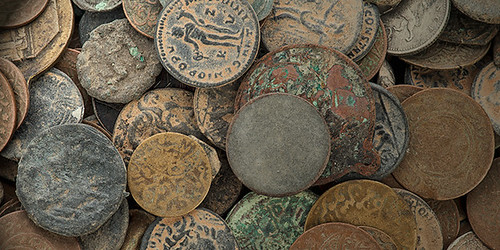
The Ancient Coin Collectors Guild (ACCG) was founded in 2004 in direct response to this trend.
According to the Guild, the organization serves as an advocate for the right of collectors to own numismatic objects “regardless of date or place of origin”. It does this through a three-pronged effort involving educational programs, consumer protection and legal action.
In 2009, the ACCG initiated a test case involving ancient coins that members of the group had imported from Cyprus and China. The hope was to challenge then-recent changes in the U.S. Government’s agreements with the two countries that suddenly made such transactions prohibited by law. Eight years later, aspects of the case continue to slog through the courts, with the latest update coming just weeks ago on September 28.
And whether that’s due to bureaucratic foot-dragging on the part of the federal government or not, the dogged determination of the ACCG to see the case through should be inspiring to other collectors. So to catch everyone up on one of the bleeding edges of coin advocacy, CoinWeek brings you a brief history on the case and provides a little legal background to help you make sense of it all.
The lengthy article walks through the major events in the ongoing case, introduces the parties and politics on all sides. Great job! Be sure to read the complete article online. Stay tuned for more - the organization filed its latest brief in the case on September 28, 2017. -EditorTo read the complete article, see:
Ancient Coin Collectors Guild Continues Fight Against Coin Seizure (https://coinweek.com/ancient-coins/ancient-coin-collectors-guild-continues-fight-against-coin-seizure/) MORE ON COMPTROLLER OF THE CURRENCY REPORTSLoren Gatch writes:
You recently reported on the upload to the Newman Numismatic Portal of a run of Comptroller of the Currency annual reports, courtesy of the Federal Reserve Bank of St. Louis. As it happens, a few weeks ago, someone inquired on the Society of Paper Money Collectors (SPMC) Facebook page about the availability of these same reports between the years 1980 and 2002; after 2003 they can be found on the Office of the Comptroller of the Currency government website.
I poked around on the correspondent's behalf, but didn't find anything that was accessible online. Hard copies exist of course in government document repositories, but that is much less convenient for researchers.
I checked with NNP Project Coordinator Len Augsburger; NNP staffers are working to fill in the gaps. -EditorLen Augsburger writes:
1863-1980 are already on NNP
Starting in 1981, the OCC's annual report was published in the OCC's Quarterly Journal. WashU does not have hardcopies for the period 1981-1997. The St. Louis Federal Reserve library confirmed they have the OCC Quarterly Journals for the period in question. I picked them up from the St. Louis Federal Reserve Bank library on Thursday, and they will be scanned shortly. In addition to appearing on Newman Portal, the scans will be shared with FRASER, their online library.
From 1998 forward the OCC Quarterly Journals are online at
https://www.occ.gov/publications/publications-by-type/other-publications-reports/index-quarterly-journal.html. We will pull these into NNP.From 2003 and on the OCC annual report resumes and is at
https://www.occ.treas.gov/publications/publications-by-type/annual-reports/index-annual-reports.html. We will pull these into NNP.Great! The following is from the NBS Facebook Group. -Editor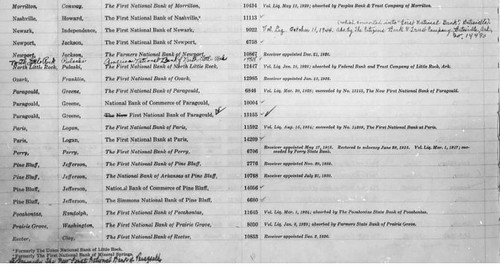
Andrew Pollock writes:
A current research interest for me is national banks, and I found a document that may be of interest to others. "List of Active and Closed National Banks" It's from the National Archives and is digitized. Unfortunately, it doesn't appear that an option exists to download the entire document.
https://catalog.archives.gov/id/6117656. The document is several hundred pages. The scan is part of one page listing Arkansas banks . This work has lots of dates and other details for closed banks; unfortunately, charter dates are not included. The source appears to be the Office of the Comptroller of the Currency.The expansion of the availability of primary resources on the internet such as the serials "Annual Report of the Comptroller of the Currency" from 1863 through 1980, and "Individual Statements of Condition of National Banks" from 1923 to 1940s provided so much low-hanging fruit, that I succumbed to the temptation to harvest and collate it, but the amount of data is so vast that several years will be required to do the work.
To visit the NBS Facebook group, see:
Numismatic Bibliomania Society Public Group (https://www.facebook.com/groups/1145253708909091/)To read the earlier E-Sylum article, see:
NEWMAN PORTAL ADDS COMPTROLLER OF THE CURRENCY (http://www.coinbooks.org/v20/esylum_v20n40a08.html) A popular money museum in Edinburgh, Scotland is closing. Here's an excerpt from an article in The Herald. -Editor
A popular money museum in Edinburgh, Scotland is closing. Here's an excerpt from an article in The Herald. -Editor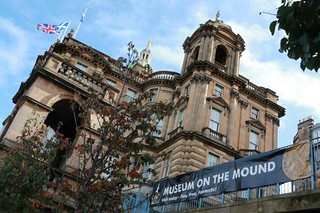 A MUSEUM that holds Scotland's oldest banknote and has one million pounds on display is to close.
A MUSEUM that holds Scotland's oldest banknote and has one million pounds on display is to close.
Lloyds Bank is shutting the popular Museum on the Mound, at the historic old Bank of Scotland head office in the heart of Edinburgh
The museum is visited by more than 50,000 people a year and was opened 11 years ago by author Ian Rankin. It will close at the end of December.
The eight room museum, which is free and popular with school groups, is known for its exhibition of a million pounds, Scotland’s oldest banknote, and an interactive display on safe-cracking.
It also shows the Bank of Scotland’s original founding act from 1695, the ledger to attract its first investors and the bank’s 18th century iron money kist or chest.
The closure decision has dismayed supporters of the museum, and will lead to several job losses.
Cllr Alex Staniforth, the Green’s culture spokesman, said: “It would be a real shame to lose the museum, which is a valuable educational resource for local schools as well as a visitor attraction, because Bank of Scotland wants to save a bit of money.
Lloyds, however, said that the closure of the museum did not mean that the future of the entire historic site on The Mound, and its landmark building, was in question.
The museum is within the imposing 19th century building, which was completed in 1878.
“It remains a core site for the Group,” a spokesman said.
He said material owned by the banking group will be returned to its Edinburgh archive site.
Such a shame. It's sad to learn of the closing, but at least the public had access to it for a number of years, and the collection remains intact, perhaps for display again another day. -EditorTo read the complete article, see:
Anger as bank's Museum on the Mound to close at end of year (http://www.heraldscotland.com/news/15596700
.Anger_as_bank_s_Museum_on_the_Mound_to_close
_at_end_of_year/) FINEST 1820 NORTH WEST COMPANY TOKENNumismatic Guaranty Corporation (NGC) has certified the finest known 1820 North West Company token. The Canadian rarity will be sold by Heritage in early Spring 2018. Thanks to Dave Lange of NGC who provided the images. -Editor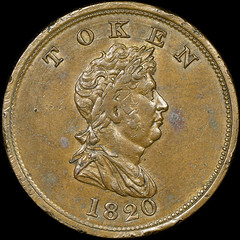

 NGC recently certified the finest known 1820 North West Company Token. Graded NGC MS 61, it is remarkable in its detail and surface quality for the issue.
NGC recently certified the finest known 1820 North West Company Token. Graded NGC MS 61, it is remarkable in its detail and surface quality for the issue.
This example first appeared in public auction in 1952 during New Netherlands' section of the ANA auction, described as: “Absolutely the finest specimen of this rarity we have ever seen.” It was acquired by legendary dealer Wayte Raymond and sold as part of his estate. It next appeared at auction on May 11, 2004, in the John J. Ford, Jr. Collection, Part 2 sale. Described again as “one of the finest seen,” it realized a record price for the issue, $48,300.
The North West Company was established by Montreal fur traders in 1779 and rapidly expanded across North America and into Oregon Country. With great success, North West’s agents bought animal furs and beaver pelts from trappers and natives. Gradually, competition and territorial disputes with its rival, Hudson’s Bay Company, wore on North West, forcing the two companies to merge in 1821. To satisfy the requirements of its Royal Charter, Hudson’s name was retained.
Perhaps prompted by its financial position, in its final year of operation under its name, North West Company issued tokens redeemable in trade goods with the value of one beaver pelt. They were struck in England in both brass and copper and issued with holes for suspension. Their obverse shows a draped laureate bust of King George IV of England and the date 1820. On the reverse, a well-rendered beaver is surrounded by the company’s name.
To read the complete article, see:
From the Grading Room: NGC Certifies Finest Known 1820 North West Company Token (https://www.ngccoin.com/news/article/6147/north-west-company-token/) INTERESTING INSCRIBED 1861 WINCHESTER, VA NOTEA Bank Note Reporter article by Mark Hotz published October 10, 2017 describes some unusual Civil War obsolete notes. One that caught my eye was an inscribed note from nearby Winchester, VA. -Editor
Inscribed currency from the Civil War is rather hard to find, notwithstanding the occasional Confederate piece with someone’s attempted forgery of Robert E. Lee’s signature scrawled upon it. I have in my collection several unusual items of Civil War vintage. The first that I will present to you is a $1 bank note of the Girard Bank of Philadelphia, dated Jan. 9, 1862. Inscribed in bold pen on the back is the following:
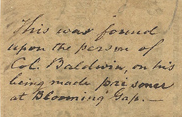
“This Note was given / to Mrs. Celia Coe / By J. G. Stewart of / the Mobile Cadets/ He took it out of / a Federal Cols. / Pocket on the Battle / field of the Seven / Pines the first Battle / he was ever in / given to her at / Winchester Virginia / October 21st 1862.”
I am sure many of you can see how this item certainly piqued my interest, and my excitement was palpable when I obtained it. I initiated an Internet search in an effort to find out more about J.G. Stewart and the mysterious Mobile Cadets. After a short but determined inquiry, I found some information that really brought the item to life.
The Mobile Cadets were none other than Company A, 3rd Alabama Infantry Regiment. The Mobile Cadets consisted of volunteers from Mobile County, Ala., and was the very first company to volunteer to serve the Confederacy. The 3rd Alabama was the first regiment from that state to offer its services to the Confederate cause and the first to be sent to Virginia for mustering duties. Jones M. Withers was elected its first colonel.
The 3rd Alabama had been held in reserve in Norfolk for almost a year without seeing any action. Its “baptism of fire” came on June 1, 1862, at the battle known as Seven Pines to the Confederates and Fair Oaks to the Federals. This battle was part of the great Peninsula Campaign in which the Union Army, under the command of Gen. George McClellan, came within 10 miles of Richmond but failed to capture it.
I have yet to determine the identity of the officer from whose pocket the note was taken, but how many colonels of Philadelphia units could have fallen at Seven Pines? If any readers can offer any further assistance here, I would be grateful.
I asked researcher Eric Schena about the Winchester note. He writes:
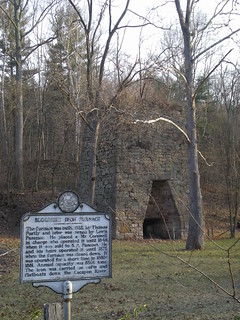
That is the type of thing I like about circulated notes, especially ones with stories. The Winchester note is not especially rare but the inscription on the reverse is neat. Hotz is correct, it's not Blooming Gap, it's Bloomery in Hampshire County, which is actually just a few minutes from where I live just over the state line. Bloomery had an iron furnace there, one of a couple in the Northern Shenandoah Valley area that was started during the Hard Times period. Remains of the stack are still visible right off of Rt. 127 (I am attaching a photo).
The interesting thing is that there is an extremely rare series of Hard Times era paper scrip that was issued by Bloomery Forge - I have only seen one example of it in person. The other interesting of note is about the Winchester note: a pile of Corporation of Winchester notes were found during demolition of the Conrad House downtown in the 1960s when the city was putting in parking. Most of the notes were in low grade, many in tatters, and most such notes today can trace their origins to that house.
To read the complete article, see:
1926 KU KLUX KLAN WASHINGTON D.C. MARCH TOKEN
Unusual Civil War vintage notes (http://www.numismaticnews.net/article/unusual-civil-war-vintage-notes)In the Numismatics-in-Fiction Department: We've mentioned Klan tokens before, and many of these are just fantasies. This one caught my eye because of the mention of a Washington D.C. March in 1926. A web search turned up a fiction book by Ellery Adams in which the token is described. Here's an excerpt - the rest of the section can be read online at Google Books. -Editor


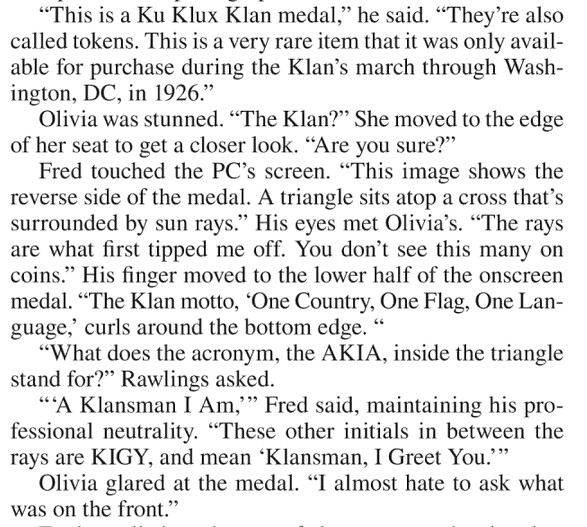
To read the complete book excerpt, see:
Written in Stone, Volume 2 By Ellery Adams (https://books.google.com/books?id=P7mLDQAAQBAJ&pg=PA92&lpg=PA92#v=onepage&q&f=false)To read the complete lot description, see:
Lot 6361: 1926 KKK KU KLUX KLAN WASHINGTON D.C. MARCH TOKEN (https://www.invaluable.com/auction-lot/-1-c-3194BBBA0A)CLAIMANTS FINALLY RECOVER LIBERTY DOLLAR ASSETSTHE BOOK BAZARRE
Jeff Kelley of Massachusetts submitted this report on his experience petitioning to recover Liberty Dollar coins he'd ordered and paid for just before the operation was raided back in 2007. Thanks! -Editor
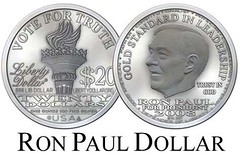
I know that The E-Sylum has occasionally published updates about the ongoing saga of the FBI raid on the Liberty Dollar operation back in 2007. As one of the claimants seeking to recover seized assets I can report that the process has finally come to a conclusion.
Back in March of 2015 I submitted a petition to recover assets that I had ordered and paid for, but never received due to their seizure in the FBI raid of the offices of Liberty Services on November 14, 2007. By 2015 the trial of Bernard von Nothaus was over, and the equally messy issue of what to do with the seized assets was being addressed. Reports in the numismatic community made me aware of the opportunity to file a claim, and so I did. It was an interesting experience to be involved in this historic case.
The Court was quite generous in considering claims that had incomplete or missing proof of purchase or ownership. My unfulfilled order from late 2007 had been processed online, and I had no receipts or emails to offer as back up to my claim; my notarized petition was all I was able to provide. My claim, like most that were submitted for assets that were not determined in the prior court case to be “contraband”, was approved (certain Liberty Dollar designs were determined to be “counterfeit” and were ordered to be forfeited).
Over the ensuing two and a half years I occasionally received paperwork from the Court announcing that various stages of the process had reached a conclusion, and then a month or so ago I finally received a notice advising that the assets due to successful claimants were ready to be returned.
As instructed, I emailed the U.S. Marshall’s Service to confirm my address, and on October 6th I received a Priority Mail package from the Texas auction house which frequently handles seized assets for the government. Most of the claimants in this case seemed to be due silver “Liberty Dollars”, some in quantities of hundreds or even thousands of ounces. Since I had only purchased some of the medallions as numismatic novelties, my recovered assets were a bit more modest. Upon opening my package I found my 20 copper Ron Paul “Liberty Dollars”, carefully wrapped and bearing a mellow toning from their decade in government storage.
To read earlier E-Sylum articles, see:
GOVERNMENT IS SUED OVER SEIZURE OF LIBERTY DOLLARS (http://www.coinbooks.org/esylum_v11n26a25.html)
SO ... WHATEVER HAPPENED TO BERNARD VON NOTHAUS? (http://www.coinbooks.org/esylum_v13n43a21.html)
LIBERTY DOLLAR CREATOR BERNARD VON NOTHAUS SENTENCED (http://www.coinbooks.org/esylum_v17n50a16.html) GALVANO RELIEFS: GILDING THE LILLYDick Johnson submitted these comments on an interesting Tiffany clock which incorporates galvano reliefs. Thanks! -Editor
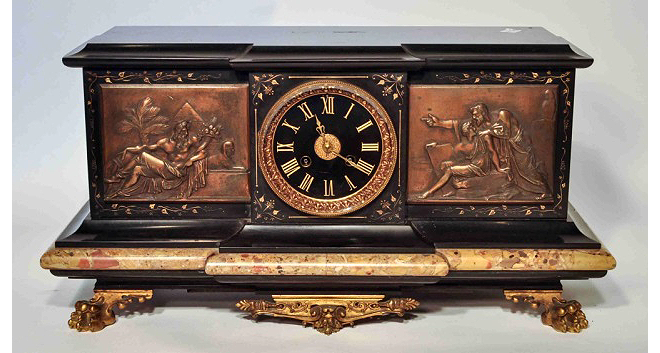
Illustrated is one of the most exquisite examples of mounting galvanos on a decorative object. The mantle clock, made for Tiffany, embraced many techniques by master craftsmen to create such a well-designed utilitarian object. In addition to electrocasting the reliefs to form the galvanos , constructing a wood housing, it also included gold-leaf application and casing the feet and a bottom central décoration, finally gold plating the external metal parts.
Galvanos are noted for decorating furniture and other wood objects. This Tiffany mantle clock is an extreme example. The two galvano reliefs are adjacent to the black-face clock, gold-leaf designs decorate black wood, probably ebony and marble border is added to the base. All on gold plated feet with a center decoration.
The clock sold at auction October 14th by the Boston firm Terri Peters & Associates.
For more information on the sale, see:
Oct 14th, (Saturday), 2017 - Important Fall Worldwide Estates Auction includes 17th Century to Mid-Century Modern Furniture, Artwork and More! (http://terripetersandassociates.com/itemlist/category/
181-july-22-saturday-2016-important-summer-auction-
includes-18th-century-to-mid-century-modern
-furniture-artwork-and-more) FEATURED WEB PAGE: THE SONG ECONOMIC REVOLUTION This week's Featured Web Page is suggested by John and Nancy Wilson. Thanks!The use of paper currency was initiated by merchants. To avoid having to carry thousands of strings of coins long distances, merchants in late Tang times (c. 900 CE) started trading receipts from deposit shops where they had left money or goods. The early Song authorities awarded a small set of shops a monopoly on the issuing of these certificates of deposit, and in the 1120s the government took over the system, producing the world’s first government-issued paper money
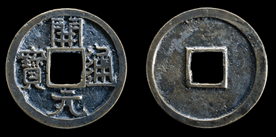
http://afe.easia.columbia.edu/song/econ/money.htm ?

